 Autumn is here so why not kick off the new season by starting a new project or getting organised! it presents the perfect opportunity to have a bit of a change! So why not get your cat or dog involved with your overhaul so that they can start the season in tip-top condition! So, how do you begin to clean up your cat or dog’s life?
Autumn is here so why not kick off the new season by starting a new project or getting organised! it presents the perfect opportunity to have a bit of a change! So why not get your cat or dog involved with your overhaul so that they can start the season in tip-top condition! So, how do you begin to clean up your cat or dog’s life?
Remove Pet Hair From Around the Home
Before making a start to your cat or dog’s clean, grab the supplies and get to work on removing any pet hair or dirt from around the home. Many pet parents will agree that getting rid of animal hair from around the house seems to be an impossible task, especially if you’ve got a cat or dog that sheds a lot.
However, there’s no need for harsh chemicals when cleaning the house with pets. For your carpets, a top tip is to sprinkle down some baking soda before hoovering. Not only will this help to remove hair, but the baking soda will minimise odours. Just be sure to use a hoover that has been specifically designed for dog and cat hair to make things a bit easier!
When it comes to cleaning fabric sofas, you can simply use a dry sponge and this will pick up any cat or dog hair lying around. For more household cleaning tips with pets, you can read our previous blog Cleaning Tips For Dogs Who Love Mud!
Using a pet blanket on top of beds and sofas, however, is the best way to keep your furniture protected in the first place, as well as providing your pet with a cosy spot to relax.
Clean Your Pets’ Beds
Now that the household clean is complete, it’s time to focus on your pet, and a great place to begin is by cleaning their bed. We wouldn’t like to sleep on a dirty mattress, so neither would our pets. And with dogs sleeping between 13 and 14 hours a day, and cats between 12 and 16, it’s fundamental to provide them with a clean, secure, and safe place to rest. Fortunately all Omlet beds are conveniently easy to clean, with removable covers and toppers that are machine washable.
Alternatively, treat your cat or dog to a new bed this season. For cats, the Maya Donut Bed comes in a wide range of colours that can add a touch of freshness to your home for the season. The Topology bed is perfect for dogs, with the option of raised feet, which improve home hygiene and airflow.
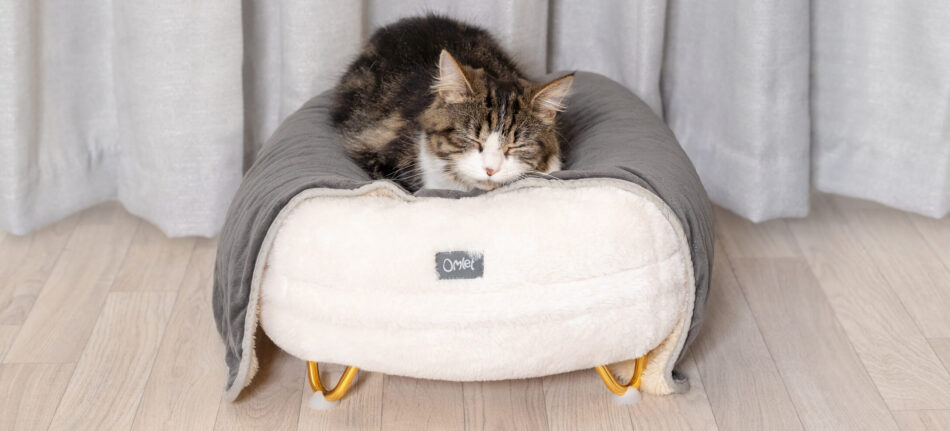
Give Your Cat or Dog a Groom
Your clean wouldn’t be complete without a bit of a pet makeover! Well, not necessarily a full head to paw transformation, but a good bath and brush go a long way! Depending on the breed of your dog or cat, they might need to make a visit to the groomers, but it’s a good idea to keep on top of a basic regime at home. Furthermore, grooming is not only for your dog or cat’s appearance but is also important for your pet’s health by aiding with keeping their skin healthy and preventing fleas or ticks for example.
Treat Your Pet to Some New Toys and Entertainment
A few new toys will be greatly appreciated by your cat or dog, as they adjust to the new season. Or how about treating your cat to their very own catio, which is perfect for indoor and outdoor cats alike, who love adventuring but need to remain safe in the garden.
There’s nothing stopping you from beginning your tidy up from today! Before you start cleaning your home, however, it goes without saying that any cleaning products you use in your house should be pet-safe, so always make sure to check the labels. How will you be cleaning up your cat or dog’s life?
This entry was posted in Cats
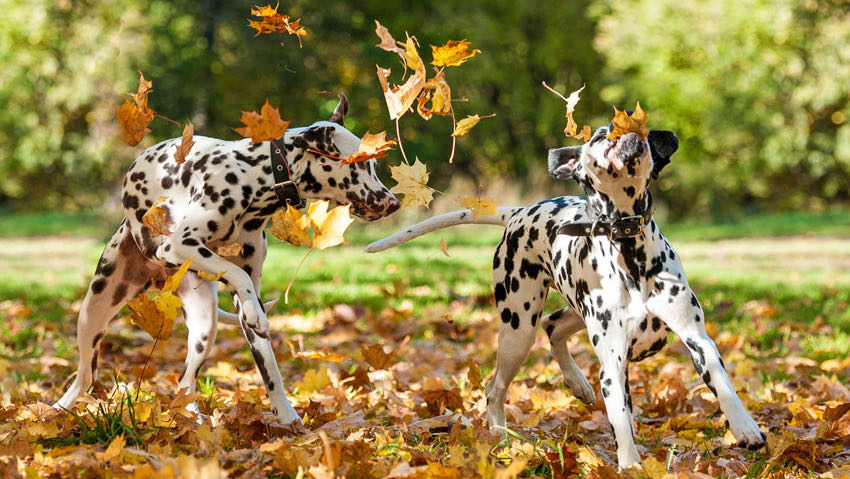
Most dogs love autumn. The children are back in school, which means the house is quiet during the day, and their favourite parks and walking trails are calmer. They’re allowed back on the beaches, there’s no pollen in the air and the temperature is pleasantly cool enough to be able to run around without worrying about overheating. And we haven’t even mentioned jumping in piles of crisp raked-up leaves! Safe to say there’s a lot to look forward to in the coming weeks for both canines and humans, but to make this time of year as amazing as possible for your furry friend, there are some things you might want to invest in or stock up on. Here is some advice and a useful checklist of what your dog needs this autumn.
A warm and comfy bed
When returning to the house after a rainy walk at this time of year, you’ll appreciate getting yourself comfortable with a cosy blanket on the sofa, or even under the covers in your bed. Your dog will feel exactly the same. Make sure your dog has a soft and supportive bed to rest on as the nights draw in. The Omlet Bolster dog beds have a high-performing memory foam mattress that will mould itself around your dog as they relax their bodies, and will provide them with a long, restful sleep all night.
Having a safe and warm space to return to after hours of autumn play is especially important if your dog is still a puppy. Keep your pet’s bed close to the central heating or in a room with a wood burner so they can be in the same room as the rest of the family, and make sure it stays warm throughout the night.
Coats for dogs
Dogs of all breeds can benefit from wearing a dog coat on walks to give them extra warmth and comfort during autumn and winter, but it’s extra important for small or short-haired dogs who are not naturally evolved to deal with lower temperatures.
Dog jackets are available in a wide range of styles and materials, and which you decide to go for is up to you, but we would recommend choosing a waterproof version that’s easy to clean.
If your dog is not used to wearing a coat it might take some time to get them comfortable. Start slowly by letting them sniff and explore the material, rewarding them with treats to give reassurance. Once they seem comfortable around the coat you can put it on for short periods in the house or in the garden, slowly increasing the time.
Reflective collar and lead
To make sure you and your dog are visible when you go for your early morning or evening walks, it’s a good idea to get a reflective collar and/or leash that will alert passing cars. Many walkers carry torches when walking in the dark, so reflective gear can be useful even if you’re not around vehicles. You can also get collars with LED lights that will make sure both you and others can spot your dog on country walks off the leash.
Controlling ticks and fleas
Don’t stop giving your dog tick and flea repellent treatments just because summer is over. Fleas and ticks can still be lurking when your dog is out for a walk and can find their way into our warm homes.
Dealing with mud
Even if your dog is not a fan of jumping in puddles, running through high grass or rolling in wet leaves, walks are going to get wetter and muddier as autumn approaches, so it’s worth making sure that you have everything at hand to deal with a cold and dirty dog. If you’re driving home from walks, it’s a good idea to have a towel or a dog blanket to dry off your dog before they get in the car to make sure they don’t get cold. A waterproof seat cover is another solution.
Get a dog-friendly shampoo for bath time, and a good brush to get rid of dirt and debris from the coat. If you’re not meticulous about cleaning your dog, it’s ideal to have a dog bed that is easy to keep clean like the Omlet Bolster dog bed. With a removable cover, it can easily be zipped off and put in the washing machine when dirty.
Grooming your pet
Your dog will start growing their winter coat in preparation for the colder season. To make sure it’s as healthy as possible, you can give your pooch a groom to get rid of dead hair and matted fur. This is especially important if your dog’s coat is very long or difficult to keep clean. You can start by just brushing through the hair, but if you’re able to it’s always good to let a professional groom your dog.
Keep your dog safe
Autumn does unfortunately also come with some pet hazards. Be aware that antifreeze is highly poisonous to dogs, and can result in acute liver failure and even death. Signs that your dog might have eaten something they shouldn’t include vomiting, seizures and difficulty breathing, so call your vet immediately if you notice any of these symptoms.
Rock salt used on the roads as grit could also be dangerous if ingested, so make sure you clean your dog’s paws thoroughly after walks.
Also, be aware that all sorts of dangers can hide under leaves and on muddy paths. Broken glass, toxic food or litter can seriously harm your pet, so to keep your dog happy and healthy it’s important to always keep a close eye on them when they’re exploring.
Omlet and your dog’s autumn
If you come prepared, this time of year should be a real treat for both dogs and humans, ideal for spending quality time together walking, playing and snuggling. And with Omlet’s Bolster dog bed, dog blankets and dog accessories, this autumn will be the best one yet.
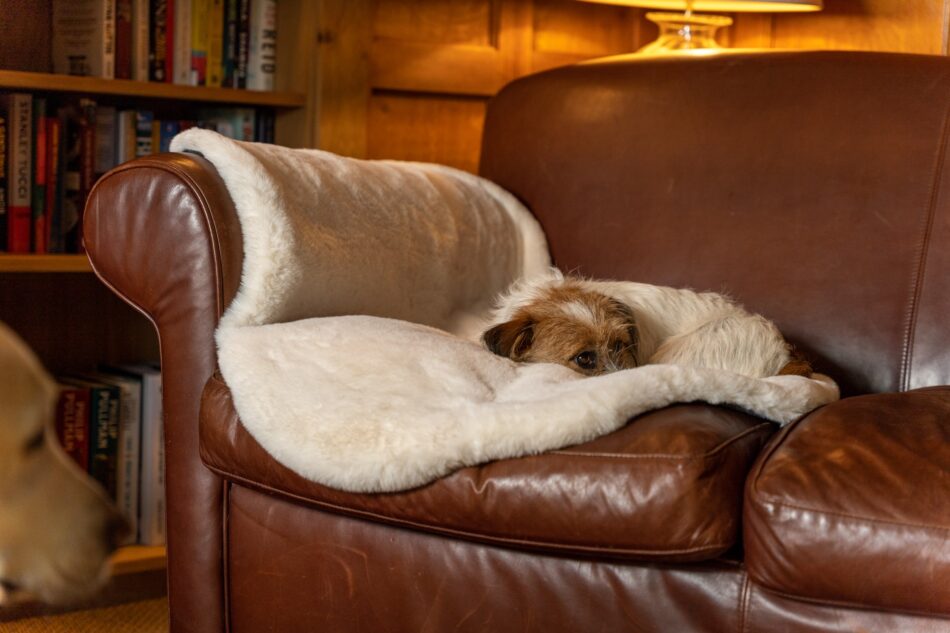
This entry was posted in Dogs
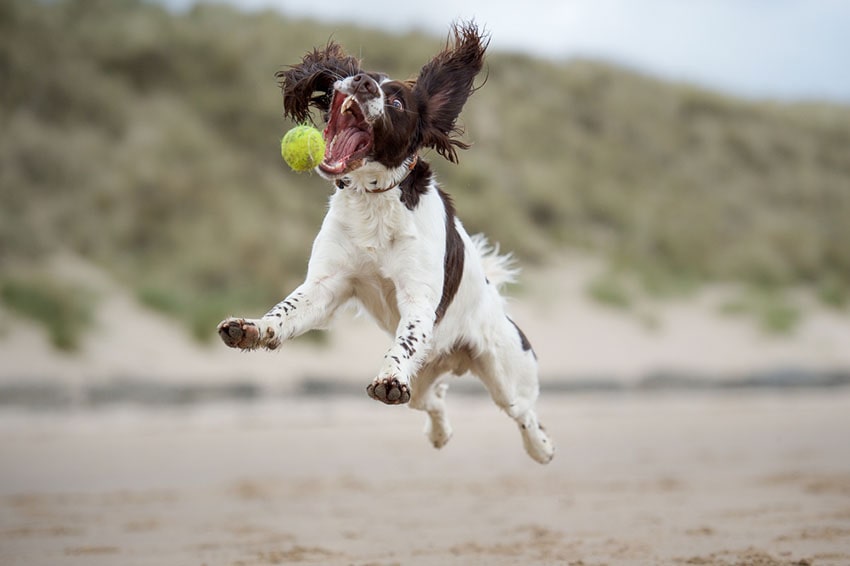
At some point, most dog owners will relate to not being able to find the motivation to get out of the house for a daily dog walk. But, when it comes to our four-legged companions, keeping on top of their exercise regime is essential for their physical and mental well-being. Rest assured though, walking your dog doesn’t have to be a chore thanks to these 11 tips on how you can make dog walks more exciting.
Encourage sniffing
Allowing for a few dog sniff breaks is a fantastic way to make your walk a lot more exciting for your furry friend. Did you know that scientists estimate that a dog’s sense of smell is anywhere between 10,000 to 100,000 times more accurate than ours?! So, while it might be slightly frustrating to feel as though you’re always stopping for your dog to explore, it’s crucial not to forget that this is how our dogs navigate the world. So next time you’re on a walk, give your pup some extra time to use their nose, and you’ll probably have a much calmer dog when you return home too.
Snap some Insta-worthy pics
Could your dog be the next big pet influencer? Why not have some fun and get your pup posing for a few pics while you’re out walking? Accessorize with a cool lead and matching collar and you’re already halfway to getting the perfect pet pic.
Next, you’ll want to find a setting where you can get your dog’s attention to have them sit nicely whilst you snap away. You can find some tips on how to nail your pet photography in our How to take better pictures of your pet blog.
Take playtime outside
Dog games don’t have to be restricted to within the home. Most dogs love to play fetch, so this is always a good place to start. You can even substitute your dog’s regular ball with a treat toy for dogs you can hide some of their favourite snacks in. This will make their usual game of fetch more mentally stimulating and even maybe tire you out as well.
Alternatively, nose work games are also a great idea to incorporate into your dog’s walk, providing them with plenty of mental enrichment. Teach your pup the “find it” command and throw some treats into the grass to have them sniff out where you’ve placed them.
Practice training
Dogs need training throughout their lives and doing so outside whilst on walks is one way to make your regular stroll a bit more fun for the pair of you. Training outside means that there will inevitably be plenty of distractions, so keeping your pup stay engaged will require a lot of concentration. There are various ways to train your furry friend outside, from practising loose leash walking, obedience training, or maybe even agility.
Enjoy a refreshing drink together
How about taking your pup along to a country pub while on your walk? Your dog might even appreciate a little break from their trek, and it means you’ll have a bit of company should you sit down for a drink – a win-win situation! While plenty of pubs accommodate dogs, it goes without saying to just be sure to check before your arrival!
A day out at the lake
While not the case for all, many dogs can swim. Weather permitting, take your dog out for a swim in a dog-friendly lake for a splash around during their walk. If your dog is not familiar with swimming though, it’s important to gently ease them in and never force them to do anything they’re not comfortable with.
After returning home, your pup will need a cosy and warm bed to relax on. The Topology dog bed is a fantastic choice, with a range of mattress toppers including a machine washable, absorbent dog bed Microfibre Topper that simply soaks up any mud and dampness from their swim. Taking your dog swimming on walks is even better in the summertime to help them cool down. Be sure to also take a cooling mat for dogs if you plan on heading out for a long walk to the lake when the weather does heat up.
Have a dog playdate
If your dog gets along well with other dogs, invite a friend to join you on your next walk to make it feel like less of a chore. Not only will you be able to have a nice catch-up with a friend, but your dog will also appreciate meeting up with theirs too.
Go to dog meetups
If you don’t already know anyone else with dogs, dog meetups are another opportunity for you and your four-legged friend to socialize with other people and dogs. Dog meetups are usually held in parks and involve meeting and then walking with other friendly dogs from around the local area. Alternatively, breed-specific dog meetups have soared in popularity in recent years, with a large number of dogs of the same breed all gathering in the same space for one big walkie.
Go somewhere new
Just like us, dogs enjoy a change of scenery. Doing the same thing, in the same place, every single day will eventually lead to you and your dog becoming very bored, so it’s a good idea to every so often change your route on walks. If your dog doesn’t mind getting in the car, you can even head out slightly further out on an adventure to give your dog a whole new experience, such as travelling to a beach. Should you be making a longer journey, Omlet’s range of secure crates like the Fido Classic will help to make for a much smoother ride.
Change the pace
Another way you can make the daily walk more exciting is to change the pace. Speeding up and slowing down at some points of the walk will get your dog’s mind ticking by keeping them engaged with you as they have to focus on what your next move will be.
Alternatively, for a particularly high-energy dog breed, why not change your walk to a jog? This way you’ll be able to get your workout in alongside taking the dog out! Before doing so, just make sure that your dog’s age and breed are suitable for running long distances.
Let Fido guide you
It’s often said that your dog should never be leading the way on walks. But, it can work out as a fun activity to occasionally see where your dog really wants to go. Simply take them out on their dog lead and hand directional control over to them! Although, if you’ve got a bigger dog who pulls on the leash a lot, this might not be the best idea…
Omlet and your dog
Omlet’s mission is to find solutions to pet parent ponders like how can a dog walk become a bit more exciting? And what’s the best way to travel with a dog? With products like the Topology dog bed and the Fido Classic dog crate, our designers continue to innovate products we know will inspire owners, bringing people closer to their pets.

This entry was posted in Dogs
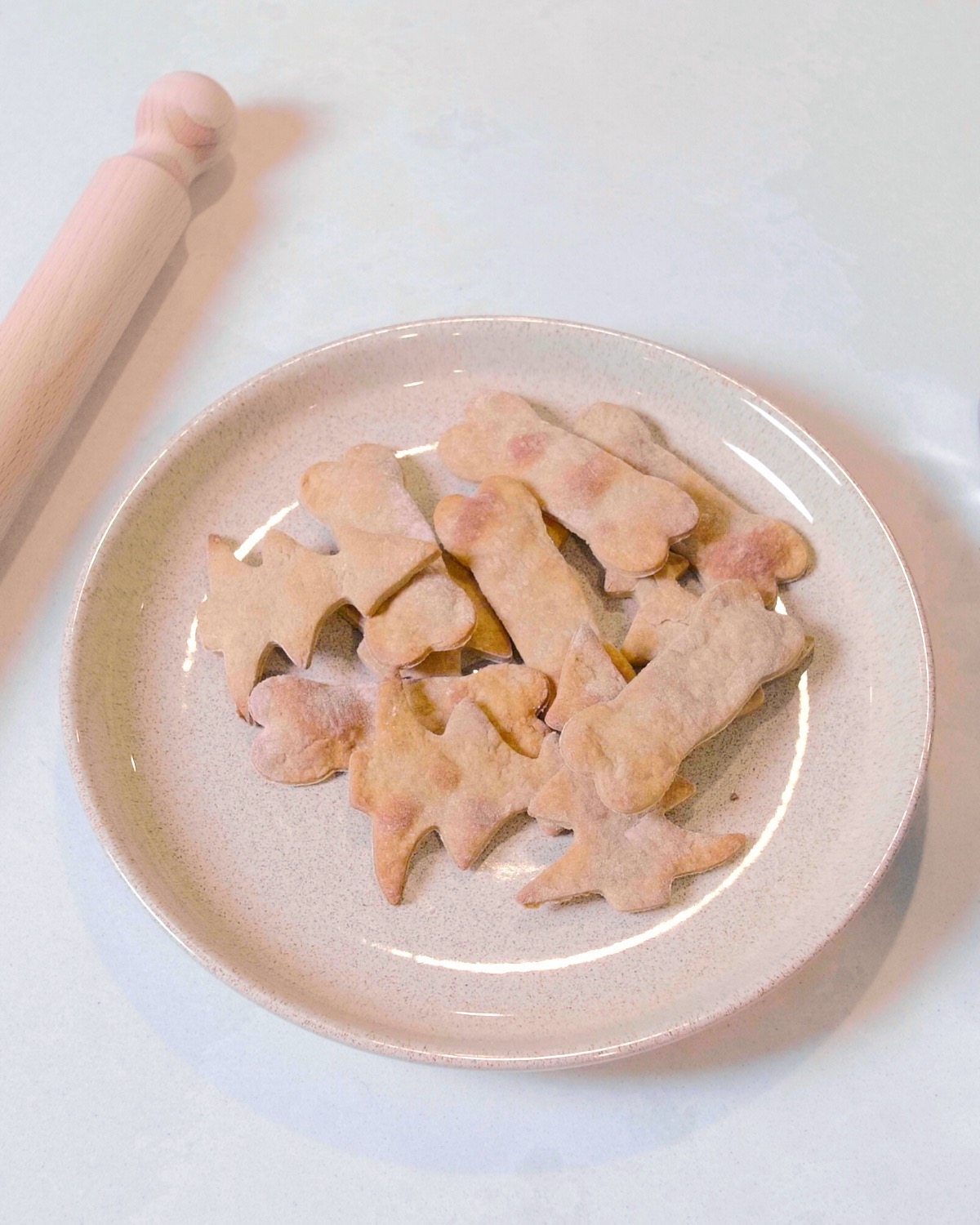
Everyone deserves a treat from Santa Paws this festive season, including our four legged friends! This super simple recipe makes around 15 dog biscuits (using a 10cm cookie cutter), and are the perfect Christmas treat for your dog!
Ingredients
- 150g plain or wholemeal flour
- 80g xylitol-free peanut butter*
- 1 banana
- 4 tablespoons hot water
- ½ teaspoon cinnamon
*Check the ingredients of your peanut butter – xylitol is toxic to dogs.
Method
Prep time: 10 minutes
Cook Time: 15 minutes
- Preheat your oven to 170°C. Mix together the xylitol-free peanut butter and hot water in a bowl.
- Add the banana to the bowl and mash with a fork until most lumps have gone.
- Add the flour and cinnamon to the bowl and use your hands to form a dough. The texture should be quite firm and sticky.
- Lightly flour your work surface and roll out the dough to about 1cm thick.
- Cut out into your favourite Christmassy shapes and place on a lined baking tray.
- Bake at 170°C for around 15 minutes or until golden brown. Once cooked, leave to cool completely before your dog does the taste test!
Your homemade Christmas dog treats can be stored in an airtight container for up to 10 days. A friendly reminder that this recipe is intended as occasional treats for your dog, and should be fed in small amounts alongside a well-balanced diet. These treats are not suitable for dogs with nut allergies or other special dietary requirements.
This entry was posted in Dogs
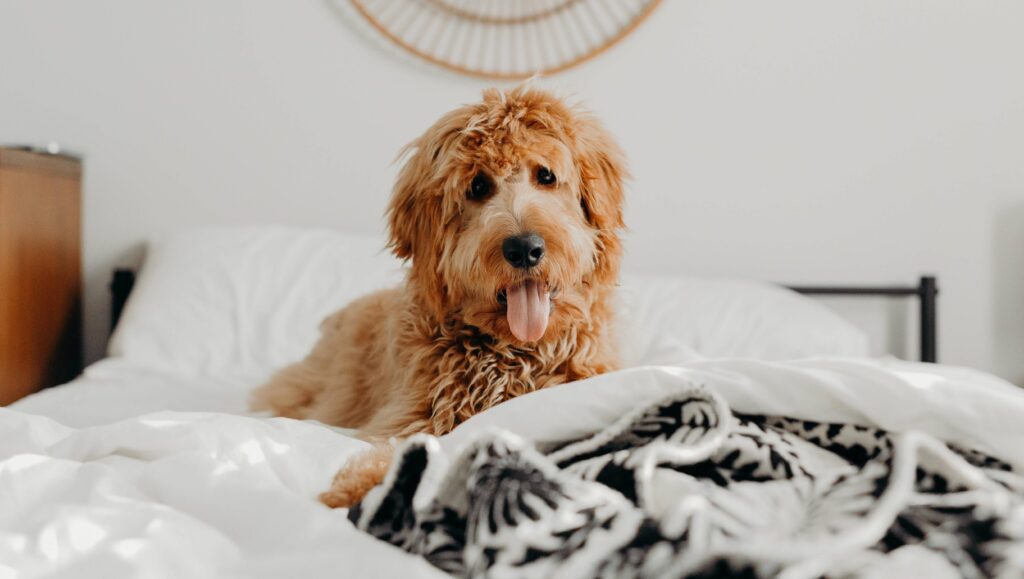
We all love our pets, and sometimes it simply seems far too difficult being apart for just a few hours, even at night. Surveys have shown that up to two thirds of people with cats or dogs now sharing a bed with their furry friend, so it’s clear that the prospect of snuggling up with the cat or dog at bedtime can sometimes be impossible to resist. Many pet owners would agree that co-sleeping with a beloved pet seems harmless. However, with sharing the bed also comes drawbacks. First of all, though, let’s talk about the main benefits of letting your pet sleep on the bed.
Benefits of Sharing a Bed with Your Pet
Bonding
Sleeping with your pet can be a great bonding experience for both parties. Dogs and cats provide their owners with physical comfort and support, strengthening your bond and relationship, which can help your pet to feel more at home.
Security
For dog owners in particular, sharing your bed with your pet every night can be a great security measure if you have any concerns about break ins. Regardless of how your dog would react to any intruders, they’re a great deterrent to any burglars and provide you with a sense of safety at night. Although your cat might not be able to put up much of a fight against any intruders, they’re highly sensitive creatures and can alert you of anything that appears suspicious, such as unusual smells or sounds.
Reduces Stress and Anxiety
Studies show that co-sleeping with your pet can help elevate your mood and reduce stress and anxiety levels. When you cuddle with your dog or cat, having that contact releases the happy hormone of oxytocin. Reduced levels of stress and anxiety levels may also help you to get a better night’s sleep.
Personal Alarm Clock
Like humans, cats and dogs sleep at night and are awake for the day (well, for the most part!). They’re both creatures of habit and love routine so don’t be surprised if you get a very personal wake up call from your pet at 6am every morning. Look on the bright side though, you might never have to set an alarm for work ever again!
Drawbacks of Sharing a Bed with Your Pet
Fleas and Parasites
Unfortunately, cats and dogs are notorious for fleas. If you regularly welcome your pet into bed for a snuggle at night, then you may also be welcoming their fleas too. Although easily treated, having fleas is an unpleasant experience for both you and your pets. More worryingly, co-sleeping with your pet could actually be putting your health at risk. Both dogs and cats can spread parasites such as tapeworm, that can make us sick.
Hair!
If your cat or dog is prone to shedding then don’t expect your bed to escape from the mess! It’s no secret to most pet owners how much of a nightmare it can be to forever be hoovering up your dog or cat’s fur from around the house, so if you don’t fancy adding another chore to the list then maybe it’s best to avoid sleeping with a dog or cat.
Allergies
It’s not a good idea to share the bed with your pet if you suffer from allergies, even if they’re not pet related. Those who suffer from asthma or are sensitive to pollen and dust for example, may find their allergies being triggered from sharing the bed with a dog or cat.
Behavioural Problems
When you allow your animals to share the bed, you run the risk of facing behavioural problems. For dogs that are prone to separation anxiety or territorial aggression, allowing them to sleep on the bed at night could only be worsening these issues. Cats can also suffer from issues such as territorial behaviour, so if you’re met with a hiss or lash out from your cat when you attempt to move them off the bed then it’s probably not a great idea to continue sharing.
If you (or your pet) do decide to sleep alone, it’s important to make sure that you provide them with a safe and cosy bed at night. Omlet stock a wide range of pet beds for dogs and cats that optimise comfort and hygiene, so that your cat or dog will be just as snug in their own space.
If you (or your pet) do decide to sleep alone, it’s important to make sure that you provide them with a safe and cosy bed at night. Omlet stock a wide range of pet beds for dogs and cats that optimise comfort and hygiene, so that your cat or dog will be just as snug in their own space. The new Maya Donut Cat Bed offers first class comfort, made with a luxurious faux fur fabric your cat will love. Or how about trying the Topology Luxury Dog Bed for your pet pooch. With a memory foam mattress base, your dog will be in their element with a number of customisable toppers to fit their personality.
So, as amazing as it can be to share the bed with our favourite furry friends, with risks such as behavioural issues and allergies to consider, the decision really is a matter of personal choice. Either way, it’s always worth investing in your pet’s own bed to give them the option to have their own safe space (however little or often it may be used!).
This entry was posted in Cats

The Omlet shop has something for everyone! With plenty on offer for dogs this year, you don’t want to miss out on this opportunity to get some great gifts for any pampered pooches (and their owners!) that you have in your life.
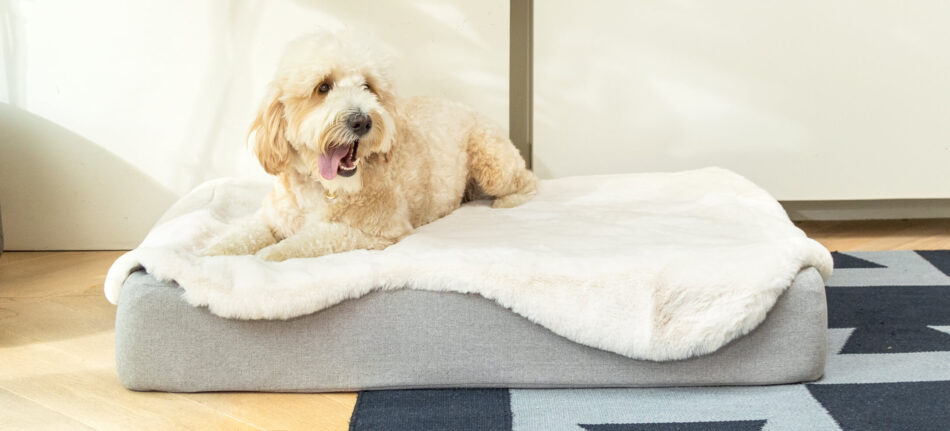
Topology Bed
The Topology dog bed is a must-have for any pup who loves to put their feet up after a long day! With a high performance memory foam mattress base, this bed is also a brilliant gift for any dogs who need that extra bit of support and comfort for their joints. Available with a number of luxury toppers, including a dreamy faux fur sheepskin, the bed is great for keeping your four legged friend snug over the festive season!
Bolster Bed
If you know someone who’s looking to upgrade their dog’s bed for the new year, the Bolster Bed is a fantastic choice. The zip-on, machine washable covers make them ideal for any puppy accidents or muddy paw prints as well.
With a range of 15 different beautiful colours and a range of designer feet to choose from, the Bolster is ideal for any dog parents who want a stylish bed to match the interior of their home! How about opting for the Sage Green or Merlot Red to really fit in with the Christmas decor?
Luxury Super Soft Dog Blanket
The irresistible Luxury Super Soft Dog Blanket will be a real treat for any pups to find under the tree this year! The ultra cosy, sherpa blanket can be placed anywhere in the home to help your dog get a great night’s sleep. You can even position the blanket in your pup’s bed for even more warmth and comfort. Now also available in a very festive poinsettia red and cream design, your dogs can get into Christmas spirit with the rest of the family!
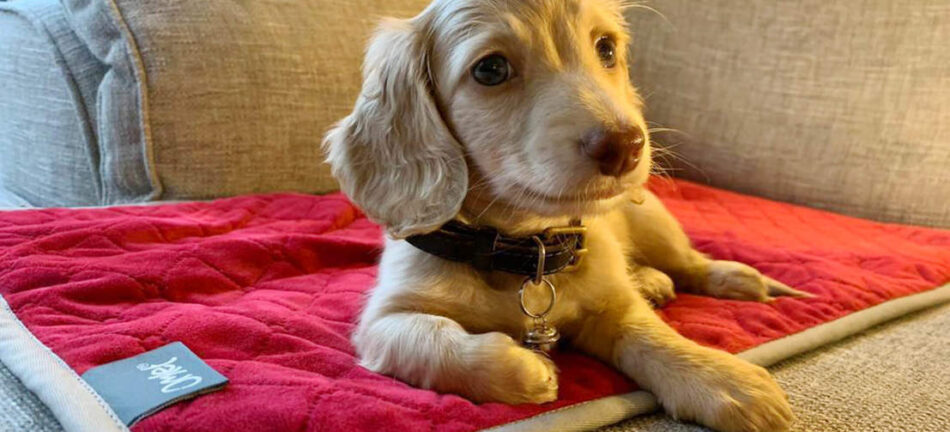
This entry was posted in Christmas


Topology Dog Beds give all dog’s that ‘clean sheet’ feeling.
A recent survey discovered that 22% of dog owners think that the dog bed takes 2 weeks to become unhygienic, yet 23% still leave it a month between washes! No wonder a dog bed is one of the 10 dirtiest spots in the home.
We’re known as a nation of dog lovers, but it has become clear that many owners do not give their dogs the sleeping experience they deserve. In fact, the survey showed that only half of dog owners wash their dog’s bed as frequently as dog and hygiene experts recommend: at least every other week.
The survey found the main reasons people struggle to keep their dog’s bed clean is that it’s time consuming and it leaves their dog without a bed while the cover is being washed and dried.
So how do we make it easier for the owners, and more comfortable and hygienic for the dogs? Enter Omlet’s newest innovation: Topology, the dog bed evolution our pets have been craving!
Topology Dog Beds feature patented, machine washable toppers that easily zip on and off a sturdy and supportive memory foam mattress. This allows owners to quickly swap to a new topper when the dirty one is in the wash. A range of designs from luxurious sheepskin to highly absorbent microfiber and even a beanbag version mean that you can find a topper that suits your dog perfectly, and looks great in your home.
After many days of rigorous play and nights of deep sleep, a worn topper can also be replaced without the need to throw away the rest of the bed. Economical, hygienic and kinder to the environment!
Another exciting feature of the Topology Dog Bed is the possibility to raise the bed with stylish designer feet. Not only does this make the bed blend beautifully in with the rest of your furniture, it also improves airflow around the bed without creating nasty drafts, minimizing dust and debris as well as unwelcome disturbances. Yet another improvement to dog bed hygiene, thanks to Omlet!
Omlet’s Head of Product Design, Simon Nicholls, says: “We wanted to combine all the things dogs and their owners find important into one ultimate dog bed, and what we ended up with was Topology. The combination of the base, the toppers and the feet provides extreme comfort and support, cleanliness and hygiene, and durability. It’s been really nice to see how different dogs tend to go for different toppers and how their favorites match their personalities!”
This entry was posted in Dogs

It’s no secret that most dogs absolutely love getting muddy, rolling around in dirt and jumping in the biggest puddles they can find! This can unsurprisingly result in a very muddy pup and several trips to the dreaded bath! Whilst we can try and prevent our dogs from getting too dirty by discouraging digging and diving into puddles, it’s inevitable that some pups just can’t help getting their paws and fur muddy. Fortunately for us though, we don’t have to let our furry friends get in the way of a clean house. Here are our top tips on how exactly you can keep your house clean with a dog that loves mud.
Tips For Cleaning Around Your Home
Daily Floor Cleaning
It may seem obvious but with a pet comes more cleaning around the house! It’s a good idea to purchase a hoover that has been specifically designed with our pets in mind. These are perfect for helping to remove a buildup of dirt left around the house from your dog and any hair that is stuck in difficult to reach spots. If you’ve got hardwood floors, you can then use a high quality, pet safe surface cleaner to mop over any leftover dirt or potential muddy paw prints.
Plenty of Throws!
Not only do throws look great around the home during this time of year, creating a cosy autumnal feel, they can also help with keeping your furniture in tip top shape! Using throws on your furniture will save you a lot of time (and money), over attempting to clean your fabric sofa. Be sure to use easy to clean throws that can simply be put in the washing machine once they get smelly or accumulate any dirt or mud. You can also get your dog their own blanket like the Omlet Luxury Super Soft Dog Blanket, which can be placed on your furniture or their bed. Not only does the blanket provide ultimate comfort, it’s also dual sided, allowing you to choose a style to best suit your interior.
Consider Dog Bed Choice
There are several dog beds on the market and sometimes it can be overwhelming attempting to choose which will be best for your pet. Something you should consider however, is how it will affect the cleanliness of your home. Without regular washing, it’s easy for your dog’s bed to quickly become dirty with hair, dust, and mud as your pup returns from the garden or a walk. Dog beds with removable covers are a good choice, making for much easier cleaning than those without. Furthermore, dog beds with feet such as the Topology bed can help with keeping your dog’s bed cleaner for longer, as well as keeping the floor beneath the bed clean, minimising a build up of debris compared to dog mattresses that sit directly on the ground.
Tips For Cleaning a Muddy Dog
 Regular Grooming
Regular Grooming
Regular grooming for your dog is essential, regardless of whether your dog has become visibly muddy or not. Whilst some breeds require a lot more grooming than others and are recommended to take regular visits to a professional groomer, you can also keep on top of their regime whilst at home. Between baths, you can use a dry shampoo to get rid of dirt and odours. You can also maintain your dog’s coat using a brush, suitable for their breed to help keep their fur healthy.
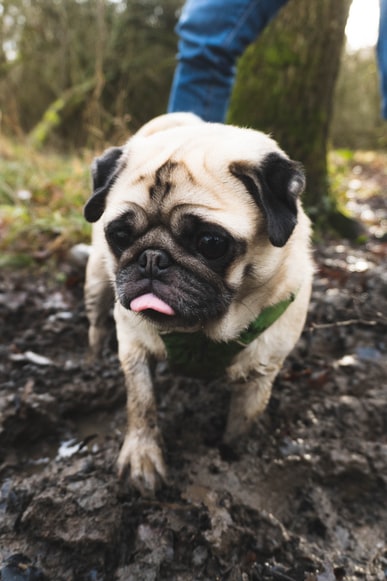 Wipe Your Dog’s Paws After Walkies
Wipe Your Dog’s Paws After Walkies
Dog paws can of course bring in dirt and mud into our homes, so wiping down your dog’s muddy paws after they come back from a walk is one way to prevent them from bringing this inside. To clean muddy dog paws and get the mud gone you can use paw wipes, specifically designed for dogs, gently rubbing away any dirt. Another great tip is to rub in a bit of natural coconut oil to your dog’s dirty paws after paw cleaning. This will help to hydrate and soothe sore or itchy paw pads.
Leave a Towel or Mat by The Door
You can leave a towel or mat by your door as another solution to keep your dog from leaving their muddy paw prints across the home. The Wet Paws Mat for example can simply be placed at the door where your dog enters the house. The mat is highly absorbent, cleaning muddy feet by absorbing the mud from your dog’s paw pads. As you would with a towel too, you can then shake off the mat outside or throw it in the washing machine.
Having a dog that loves the mud doesn’t have to spoil your home. Hopefully after reading these tips you’ll be a lot more prepared on how you continue to enjoy your dog walks without fearing about your house!
This entry was posted in Dogs
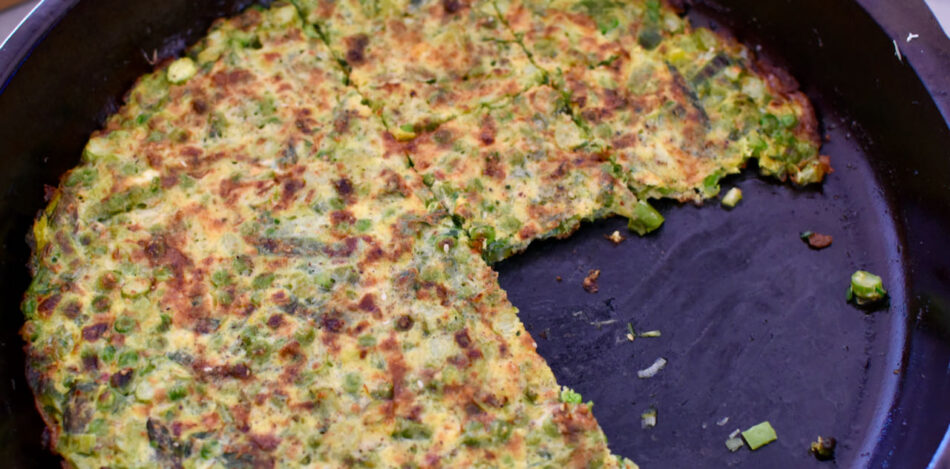
Elise Pulbrook is an Australian chef, baker, Australian Masterchef 2021 semi finalist and, as of recently, – chicken keeper! She’s sharing one of her favourite ways of using those lovely fresh eggs on the Omlet blog, a scrumptious asparagus, leek and pea frittata!
My favourite egg recipe of all time is my Zia Maria’s asparagus frittata. I’ve changed her recipe slightly, adding leek and peas. Sometimes Zia Maria adds chopped boiled potato. At the start of Spring, there has never been a shortage of asparagus in my family. Koo Wee Rup is Victoria’s asparagus country and my large Italian family has roots there. Zio Frank would bring at least one large polystyrene box of asparagus down to Melbourne every year for his sisters to divide amongst themselves.
This is a recipe I make as soon as sweet stems of asparagus come into season. To make this with my own chicken’s eggs is deeply satisfying! This is a thin frittata that is flourless and it is often referred to as an omelet within my family.
Ingredients:
- 200g chopped leek
- 200g chopped asparagus, woody ends removed
- 200g baby peas
- 10g chopped garlic, approximately 2 cloves
- 230g whisked egg, approximately 4 large eggs
- 30g fresh chopped parsley
- 2 -3 pinches of salt, or to taste (every salt is slightly different in its saltiness, know your salt!)
- 1 tsp chilli flakes, or to taste (some chilli flakes are hotter than others!)
- 1-2 pinches dried oregano or zaatar
- 40g grated pecorino cheese, or enough to cover the surface of your omelet
- Light olive oil for frying (at least 100ml, remember to be generous with your olive oil and cook like an Italian!)
Method:
1 – Heat a large well-seasoned cast iron pan or non stick fry pan. If using a 30cm fry pan, the quantities in the ingredient list will allow you to make two omelets. I have used a 35cm cast iron skillet for the frittata pictured. A rule of thumb for the success of many recipes is to choose the appropriate pan for the task at hand.
2 – Add 2-3 tablespoons of olive oil to your pan and begin to sweat your leek over a medium heat. Add two pinches of salt to help extract moisture from your leek and accelerate its cooking time. When your leek has softened and tastes sweet, add your garlic. Allow the garlic to soften and perfume the oil. Next, add your asparagus. Allow the asparagus to fry by slightly increasing the heat of your pan and allowing it to sizzle. Stir occasionally, avoiding any browning. We are aiming for a tender ‘just cooked’ asparagus with a slight crunch and bright sweetness. Add the peas and allow them to blister into radiant green jewels. The peas will only need a moment or two. If using frozen peas, you’re essentially just defrosting them in the pan. Taste the vegetables and, if they are all beautifully tender, remove them from the heat and into a large bowl.

3 – Mix the vegetables with the whisked egg, parsley, chilli flakes, a pinch of oregano and a pinch of salt.
4 – Wipe out your pan, bring to a medium-high heat and then add a generous 5mm layer of olive oil. Don’t allow your oil to smoke but do allow it to be hot enough for your frittata to sizzle once poured into the pan. Once you do pour your frittata mixture into the pan, flatten it out quickly using a spatula, pushing the mixture completely and evenly cover the surface area of your pan. Sprinkle over the grated cheese and the remainder of your oregano.
5 – Turn on the grill function of your oven to preheat while you are waiting for the edges of your frittata to start to brown. Check the bottom of your frittata by using a spatula to peek underneath. Once it has begun to brown, transfer the pan to the oven and leave to grill until the cheese on top has melted and begun to brown. Remove from the grill.
6 – Serve cut into squares as part of an antipasti selection or wedged between buttered sliced bread for lunch. Enjoy!

This entry was posted in Chickens
Meet five pawsome stars from our exciting new video, and find out more about their new favourite dog bed: Topology!
Topology is a super stylish, comfortable and practical bed that both dogs and owners will love! Machine washable toppers zip on and off the supportive memory foam mattress, so that your dog’s bed can easily be kept clean and hygienic. The range of five different toppers also means that you will be able to customise the bed to fit your dog and their personality.
We asked five of the canine characters in the Topology video to tell us which topper was their favourite and why:
Freddie love his Topology Dog Bed with a comfy Beanbag topper
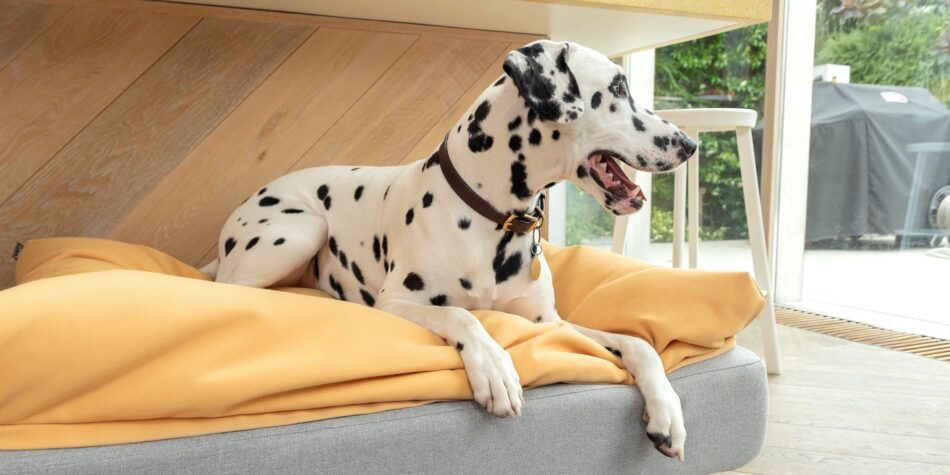
Freddie is a boisterous Dalmatian with bundles of energy! He loves showing off his jumping skills, and will happily throw himself at his bed over and over again to burn off some steam. This isn’t a challenge for the robust fabric and stitching of the Topology Dog Bed, and Freddies favourite topper, the Beanbag, is both fun and super comfortable as it fully lets the dog’s body relax as they lie down on top of it.
It doesn’t happen often, but sometimes even Freddie needs a good, long nap, and as much as the Topology dog bed can withstand his lively playing, it will also provide superb support for his resting body. Thanks to the memory foam layer in the base and the softness of the topper, Freddies owners have no doubt he’s fully relaxed and comfortable when he finally settles in for the night.
Woody could relax for days on his Topology bed with luxurious Sheepskin topper
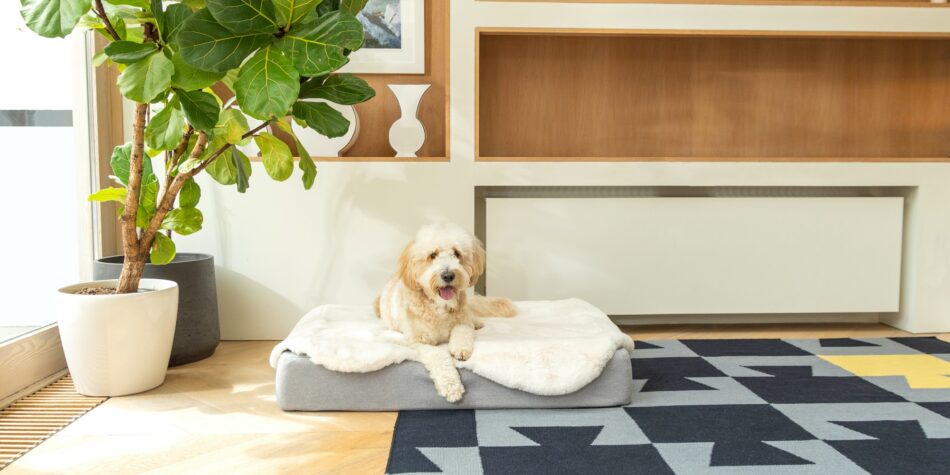
Even if neither he nor his owner would admit to it, Woody the Goldendoodle is what many would describe as a pampered pooch. He won’t settle for anything but the most luxurious of dog beds after his strolls around the city’s parks, so it’s no surprise that his favourite topper is the sheepskin.
Positioned in the best position in the living room, Woody can stretch out on his Topology Dog Bed and feel the super soft fabric against his skin while the memory foam mattress moulds around his body. Woody’s owner really appreciates how easy it is to remove and clean the topper.
Winston feels safe and supported on his Topology dog bed with Bolster topper

Little Winston is a Dachshund, and only six months old. With all the exciting exploring, learning, playing and chewing shoes he has to do all day, it’s extra important that he has a comfy bed to retreat to when he gets tired.
Winston absolutely loves the bolster topper. Not only does the perfectly padded bolster give his little head support when he snoozes, it also encloses the body to provide a den-like feeling that adds a sense of security.
Margot favours the elegance and extreme comfort of the Quilted topper
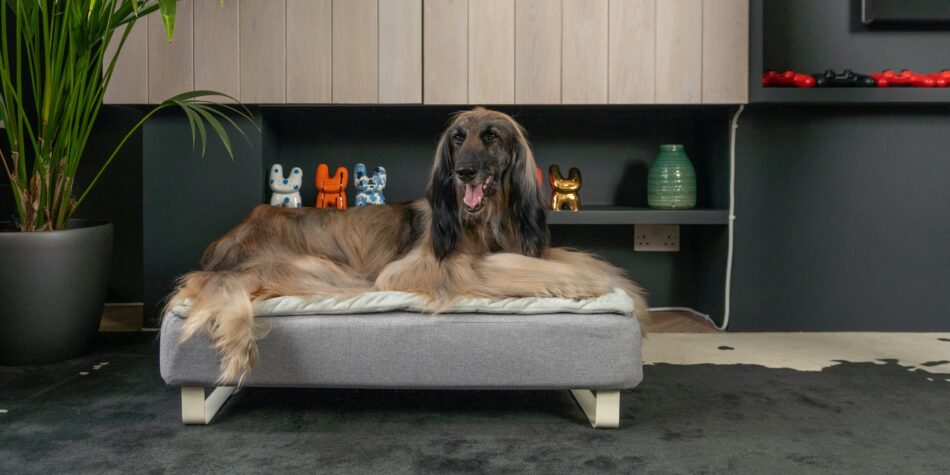
Margot is a classy Afghan Hound who appreciates the simple luxuries in life. She loves being comfortable, preferably curling up by the fire after a walk around the town when she enjoys meeting new dogs to sniff.
Margot’s favourite topper is the super soft quilted version. It stays cool against the body in summer and has a warming effect in winter, and the classic design oozes luxury and comfort. Additionally, Margot’s owners love the look of the soft minty grey against the rest of their furniture!
Esme can dry off and relax on the Microfiber topper on her Topology Dog bed
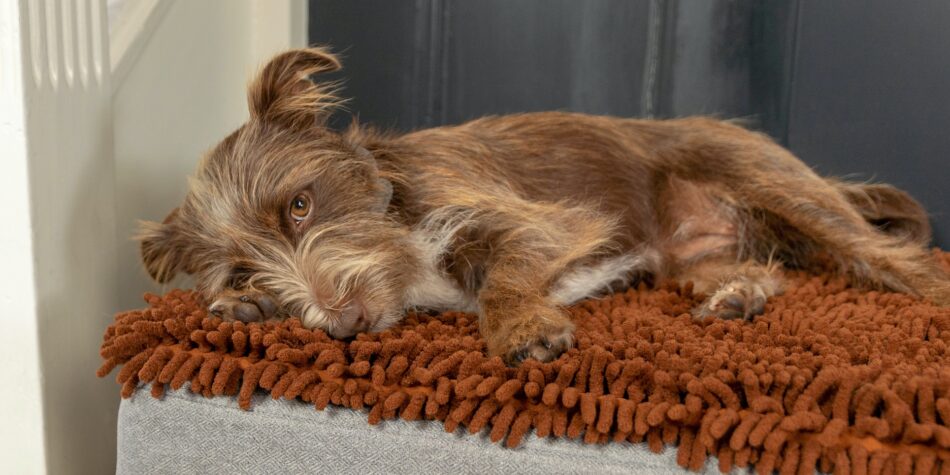
Esme is a perfectly sized terrier mix who loves nothing more than running over wide fields and chasing squirrels between trees on long country walks. Rain and wind won’t stop her – the muddier the better! That’s why the microfiber topper is her favourite. The structured fabric is nice to roll your wet back against, and it will speed up the drying process.
Esme’s owners also love that she’s got a space to dry off after inevitable hose-downs that isn’t the living room carpet! Leftover mud and moisture from walks will quickly and smoothly blend into the microfiber topper, and it can be washed over and over again, allowing for more lovely nature walks.
This entry was posted in Dogs
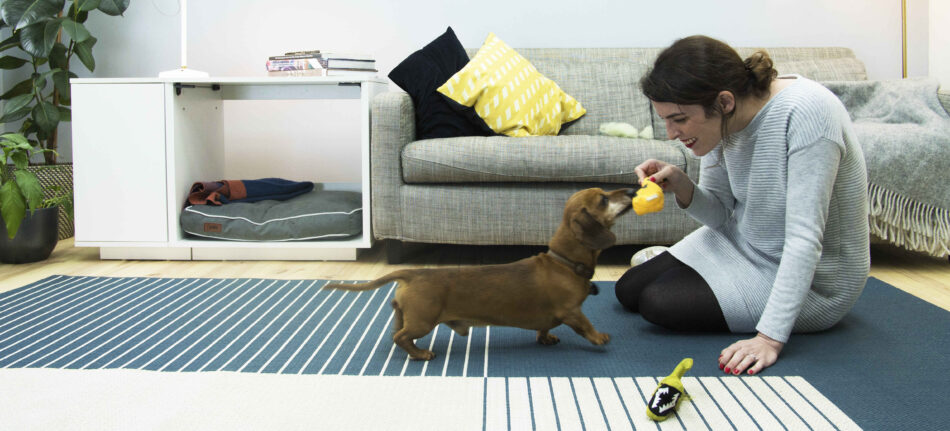
Come rain or shine our dogs need their daily walk… or two, right? But what happens when this just isn’t possible? Sometimes we can’t take our dogs outside for a number of reasons, be it extreme weather conditions, or maybe you’re in isolation. Regardless of your explanation, it’s a good idea to know how to keep on top of your dog’s physical health, as well as having an understanding of how to keep their brains engaged and stimulated whilst inside the home, even for when you’re able to take them for their regular walks again.
Although exercise with your dog inside most definitely does not substitute for your dog’s activity outdoors, there are a number of ideas to help you and your pup out, should you find yourselves in a situation when you can’t leave your home.
Physical Exercise Ideas
Tug of War
Tug of war is a great game to encourage your dog to exercise indoors. Before making a start it’s important that you’ve taught your dog the release command, to ensure they know how to drop their tug toy as soon as you ask them. Once they’ve mastered this, you can begin playing with a durable tug of war toy, which you can use to tug back and forth with your pup.
Create an Obstacle Course
An obstacle course is a fantastic way to get your dog active around the house. You can make your course as simple or complicated as you want, and you’ll probably already have most of the equipment you need in your home! You can use a children’s play tunnel for your dog to run through, or even make your own using an old cardboard box, with treats to lure your pooch in. If you’ve got carpeted stairs, you can incorporate these into the course for your pet, or even use a hula-hoop or PVC pipes to have your pup jump through. You can really get creative here, as long as your dog is supervised at all times.
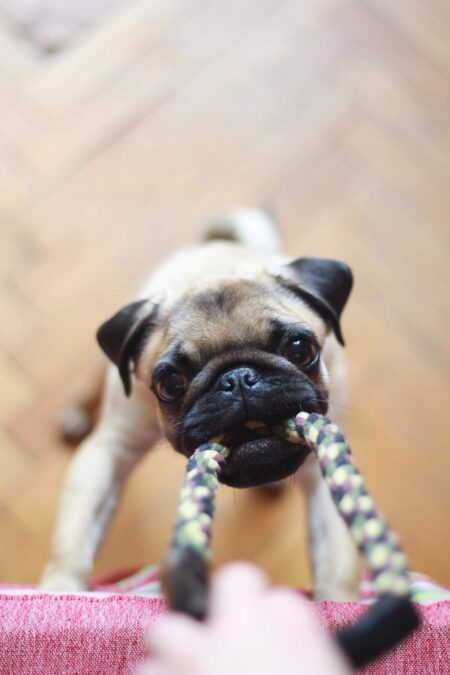 Play Fetch in The Living Room
Play Fetch in The Living Room
This is definitely one for a rainy day when it’s impossible to even play with your furry friend in the garden. This classic game is one form of indoor exercise that is bound to tire out your dog, but be wary of this one if you’re lacking the space inside (or a great aim!). Remember to always use a soft ball toy to play this game to avoid any damage.
Get a Treadmill
Treadmills aren’t just for humans! If you have a particularly active dog breed that you know is dependent on being outdoors for hours of running, a treadmill is a great way to get their physical activity in and tire them out. It’s not advisable to use a treadmill built for us to take your dogs on, so if you’re considering this option to exercise your dog, you can invest in a purpose built dog treadmill. That way you can be assured that your pup will stay safe, knowing the machine is suitable for their weight and joints.
Mental Exercise Ideas
Try Out Puzzle Toys
Exercising your dog isn’t all about physical activity. Physical and mental stimulation are both incredibly important, with mental stimulation being able to use as much energy as physical exercise for dogs. Invest in a puzzle toy like the Treat Maze Interactive Puzzle, a brain game that will really get your pup thinking, providing them with plenty of mental stimulation. Watch as your dog uses up their energy as they work out how they can get to their treats.
Play Hide and Seek
Although hide and seek can involve a lot of physical exercise, it also requires a lot of brain power from your dog. Find a hiding space and have your dog wait until you call their name to find you. When your pup finds your hiding place, give them lots of praise or reward them with a treat.
Teach Your Pup New Tricks
Teaching your dog new tricks is an activity you can do without hardly any space, and something that will keep them mentally engaged. You can begin teaching your puppy basic commands as soon as they arrive home, usually at eight weeks old. However, as your pup gets older these can become more complex and fun.
Scent Game
You can try hiding some of your dog’s favourite treats to really get their nose (and brain) working. This game is perfect for mental enrichment for your pup, and also one you can try to incorporate into your obstacle course. Before hiding your pup’s treats, teach them the “find it” command, so they know what to do when you release them to go on their scent hunt. You can first hide a treat under a towel and then build this up to hiding treats around the house.
Being stuck indoors is no fun for you or your dog, but hopefully after a bit of inspiration you’ve been able to pick up helpful tips to make it a lot less boring before you can be out and about again.
This entry was posted in Dogs
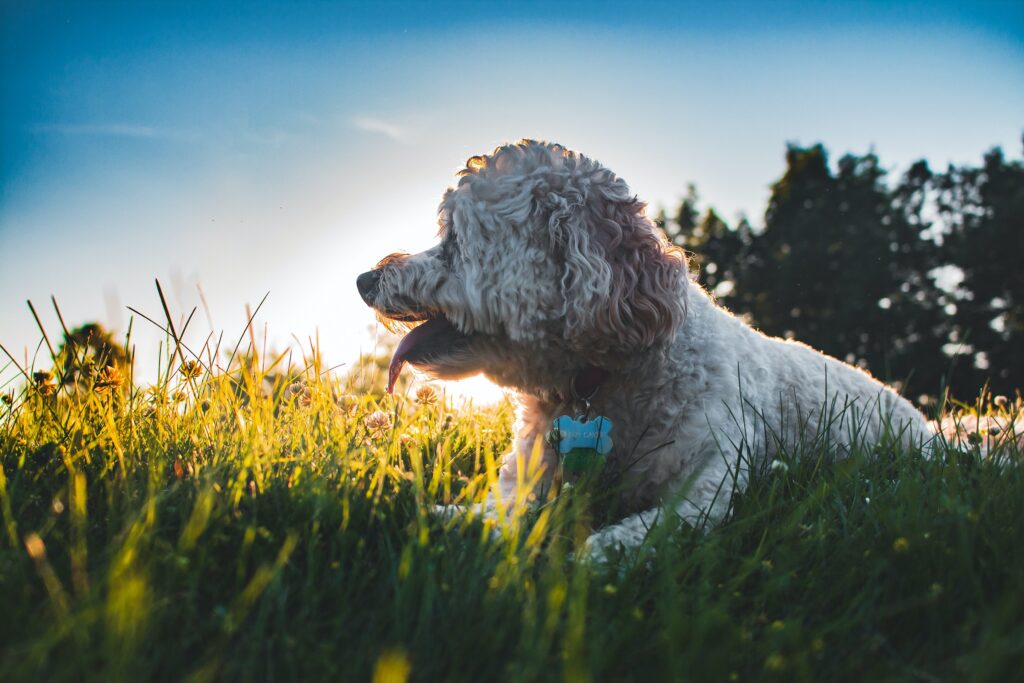
Photo by Joe Caione on Unsplash
Getting a new puppy is such an exciting time for everyone involved (even if it means a manic few months ahead of you!). A cross between a poodle and cocker spaniel, cockapoos have soared in popularity over the past few years, with their hypoallergenic coat and undeniably cute looks both playing a huge part in this! With such a loving and fun temperament, it’s hardly surprising that they have become a new firm family favourite. So, now you’ve decided that a cockapoo is the right puppy for you, where exactly do you start? Writing a puppy checklist is a good idea to get prepared before you bring your pet pooch into their new home.
Essentials for Before They’re Home
The first few days with your new puppy might be tough, as they adapt to your life and you become familiar with your four legged friend. Every dog is different but there are some essentials that we recommend for your cockapoo before even bringing them home that will make for a much easier start.
Food and Water (Including Bowls)
Puppies, of course, need a fresh supply of food and water (along with appropriate sized bowls for each). A reliable cockapoo breeder will tell you know what food your cockapoo puppy has been on before they come home, to make for a less stressful transition. Be sure to also purchase treats for your new furry friend. They’re a fantastic way to start the training process and will keep your puppy motivated.
Collar and Lead
When you pick your puppy up, they’ll probably have had a collar on to differentiate them from their litter-mates. However, you’ll want to purchase your own, even before they are able to go for their first walk. This will help to train them to get used to the feeling of a lead and collar. For size reference, cockapoos are generally medium sized dogs but this can range depending on what type of poodle they are mixed with. The general rule of thumb is that you should be able to fit two fingers under your cockapoo’s collar. Alternatively, you may wish to opt for a harness. Whichever you decide for your new cockapoo pup, make sure they are fitted with an ID tag, which states your name, first line of your address, post-code, contact number, and a message that indicates that your dog has been microchipped i.e. “I’m microchipped”.
A Crate and Bedding
When you bring your puppy home you should introduce them to a crate. A crate should never be used as a cage or to punish your dog, but should work as a den for your new cockapoo. The Omlet Fido Studio Dog Crate allows your dog to have their own private and safe place in the house, whilst the modern design will compliment your home. Happy owner and happy pup!
Puppies need sleep, and a lot of it! So comfortable bedding for your cockapoo puppy is essential. Your Fido Studio Crate can also be very easily fitted with a wide range of dog beds. The easy clean Bolster Dog Bed is perfect for puppies, it’s a breeze to throw the cover in the washing machine when it’s time for a freshen up!
A Few Extras For Your Cockapoo
Puppy pads
Cockapoos are remarkably intelligent and many puppies take to toilet training within the first few weeks. For when your pup arrives home it really is a personal preference as to whether you’d like to use puppy pads for toilet training or not. Puppy pads are massively convenient, especially to those with limited outdoor space. However, if getting up in the middle of the night to take your puppy for a wee isn’t a problem for you then you may wish to avoid this product as your pup may find it difficult or confusing to transition between the pads and outdoor peeing.
Toys
Pups love to play and cockapoos are no different here. Known for their outgoing, playful personalities, you’ll need to be stocked up with plenty of puppy toys to keep their minds occupied. Toys are also great for when you have to start leaving your puppy alone. Do make sure however, that any toys you leave with them are safe, age appropriate, and cannot be consumed! Puppies also love to chew, especially as they get into the teething stage. Be sure to explore different styles of dog toys to see how you can keep your cockapoo entertained and help with their chewing.
Grooming Kit
Although it’s wise to take your cockapoo to a professional groomer now and again, it’s also important to upkeep their grooming at home too. Purchasing a brush, comb, dog shampoo, and nail clippers is a great place to start. However, as cockapoos are of course a mixed breed, their coat type may vary. When your puppy reaches around seven to nine months old, they’ll develop their ‘adult coat’ and you will have a better indication of the best way to groom your dog.
Hopefully all the time spent preparing to bring your new puppy to their new home will help your family to transition better to life with your new furry friend!
This entry was posted in Dogs
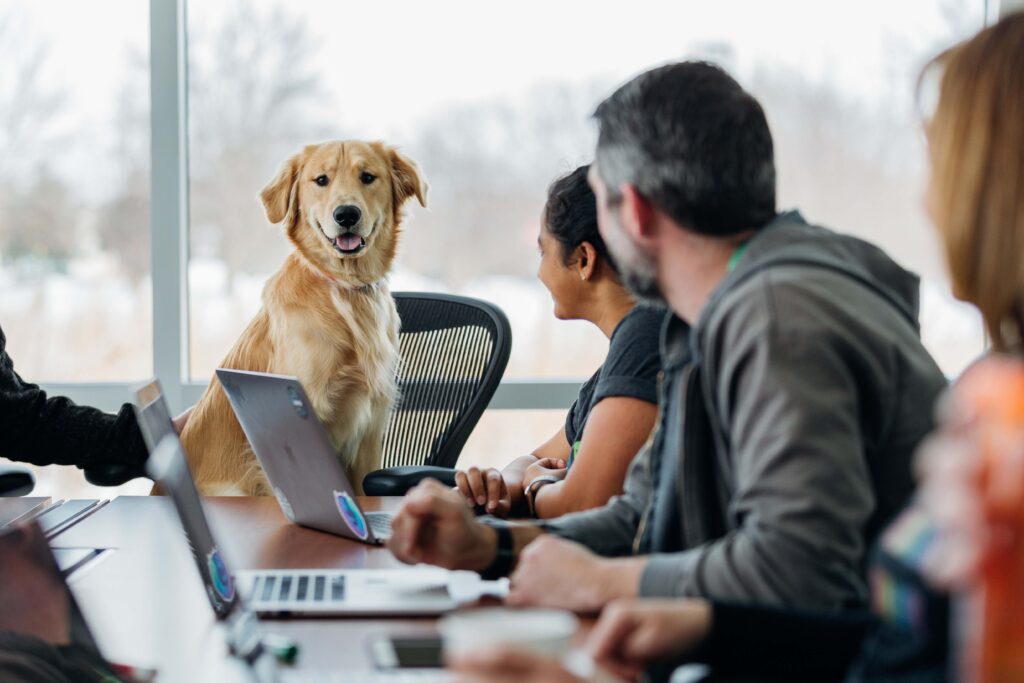
Many of us have worked from home over the past year with our best furry friends beside us, giving encouragement and comfort on the toughest of days. It’s understandable for those people that going back to the office without their canine companion could be nerve wracking and upsetting. For the dogs who are now used to constant company, new spouts of being home alone could lead to anxiety and stress. But what if there was a better solution? What if your workplace was dog-friendly? Read on as we take a look at the benefits for all parties…
How do dogs improve our mood?
It’s no secret that dogs, and pets in general, are good for our physical and mental well-being, whether that be through easing loneliness, encouraging exercise, or reducing anxiety, stress and depression. You might have felt it yourself when returning home to your dog, or perhaps going to visit a friend’s new puppy. Interacting with dogs increases our levels of the hormones oxytocin and serotonin, which are important for the regulation of stress and anxiety and also improve our mood and happiness.
Having a dog present in an office environment can significantly elevate the mood, while also improving communication, reducing tension and increasing productivity!
Can a dog-friendly workplace benefit employers?
Not only will your boss enjoy the mood-boosting benefits of a new four-legged colleague, they may also begin to notice some practical benefits for their business too.
For some employees, especially those who have been working from home for a long time now, going to the office requires someone to look after their dog, perhaps hiring a dog walker to take them out or even a hurried trip home in their lunch break to check on their dog. Understandably, this in itself can be a cause of stress for any dog owner, and being able to take their dog to the office with them is a huge job-perk which could be hard to walk away from. Could a dog-friendly office actually improve employee retention? Woof!
Do dogs enjoy going to the office?
Obviously it’s not all about us. If you’re going to be taking your dog to the office you also need to consider whether he/she will be comfortable with the new environment.
If you’re thinking about taking your dog to work for the first time, you may have to accept that the first few trips won’t necessarily be a walk in the park! Start slowly if you can, introducing your dog to colleagues and spaces gradually so as to not overwhelm them. Have a bed next to your desk so your dog can see you at all times and reward them with treats and pets regularly.
Maybe not after the first visit, but hopefully soon your dog will relax into the new environment just as if they’re at home, and new faces, sounds and smells will no longer be a cause of excitement or stress. Instead, they will feel the benefits of being close to you, just as you do!
What should you consider before taking your dog to the office?
If your boss has given the green light to bring your dog to the office, there might be some things to check before going ahead. Of course, check in with your colleagues that no one has allergies or is afraid of dogs. If other colleagues are also going to be bringing their dog to the office, consider whether your dog will be okay with that, or if it could cause some stress.
Make sure you can schedule breaks in your day to take your dog outside to stretch their legs and go to the bathroom – this fresh air time is also great for your own well-being. Make sure you have everything with you, including treats, poop bags, a water bowl and a comfy bed where your dog can feel comfortable and relaxed. You may wish to keep a set of these items at the office if you’ll be bringing your dog with you regularly.
Whether or not you decide to take your dog to the office, the most important thing is that your dog is happy and comfortable. If you are returning to full time office working, consider your options to decide what’s best for your dog.
This entry was posted in Dogs
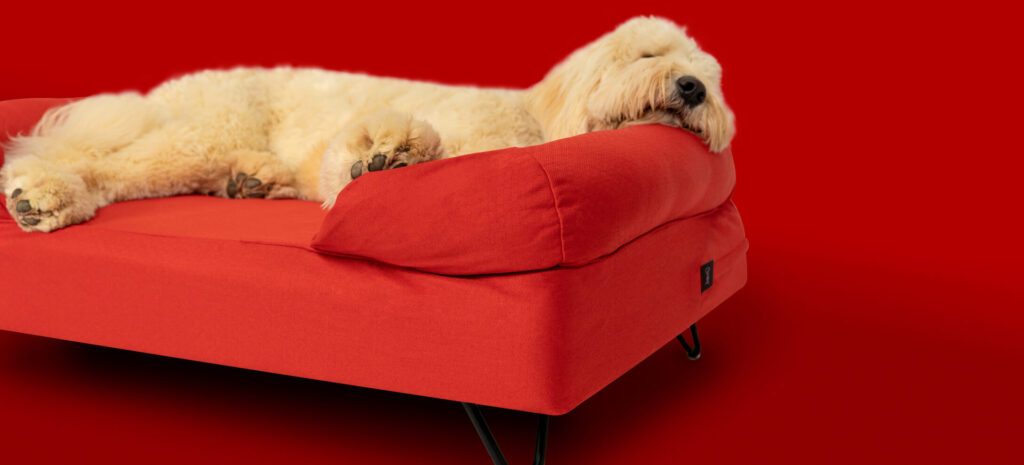
For years dog owners have been limited to beds in dull shades of brown, grey and black, but things are about to change! The Omlet Bolster Beds are now available in 15 amazing colours, ranging from a stylish Meringue White to an eye-catching Cherry Red, so there is sure to be one you will love.
Are you having trouble choosing? Why not try and match the colour of the bed to your dog’s personality? We’ve put together a quick quiz that will help you establish which colour Bolster Bed will be the perfect style for your pooch. Choose the answers that most resemble your dog, and add together the results at the end to find out which colour will suit them best!
What is your dog’s idea of a perfect day?
A. Snoozing on their bed not getting disturbed
B. Playing with the other dogs in the park
C. Going for a walk in the city sniffing outside shops
D. Digging a big hole in the garden
E. Hiking up a mountain
What’s your dog like with strangers coming to your home?
A. Doesn’t pay them any interest whatsoever
B. Jumps up and down and barks as soon as someone knocks on the door
C. Comes to have a look, but then goes back to whatever they were doing
D. Tries to get a belly scratch from anyone, doesn’t matter if they’ve never met them before
E. They will love to come and say hello, but can tell if the guest doesn’t want to play with them
What is your dog’s coat like?
A. Very, very fluffy
B. Long in some places, short in others – a bit of a mess really
C. Perfectly soft and smooth, we brush it every day
D. Short and easily maintained
E. They’ve got a lot of it, that’s all I’ll say
What is your dog’s favourite treat?
A. Dry duck fillets
B. Liver from the butcher’s
C. Ridiculously expensive organic dog treats we ship in from Luxembourg
D. Probably pizza, or anything else they’re not supposed to eat
E. Just normal dog treats will do
How does your dog feel about bath time?
A. They hate it!
B. Bath time? Are you supposed to wash dogs?
C. Loves it, especially at the groomers
D. They enjoy getting sprayed with the hose outside, but I wouldn’t trust them in my bathroom
E. They accept it, but they’re not a big fan
What is your dog’s favourite time of year?
A. Springtime, it’s warm but not too hot
B. Summer, they love going to the beach
C. They really don’t like snow, but apart from that they don’t really mind
D. Christmas, or any other time when the whole family is together
E. Probably autumn, they love jumping in the leaves
What would be your dog’s reaction to meeting a squirrel on your walk?
A. They would just look at it and keep walking
B. They would chase it up a tree, then try to climb the tree themselves
C. They would bark, but wouldn’t run after it
D. They would run after it hoping to make friends
E. They would look at me, asking for permission to chase the squirrel
If your dog was reading a book this summer, what type of book would it be?
A. A book about World War II
B. Something the other dogs in their doggy book club had chosen
C. A romance novel
D. The latest crime best seller
E. A Russian classic
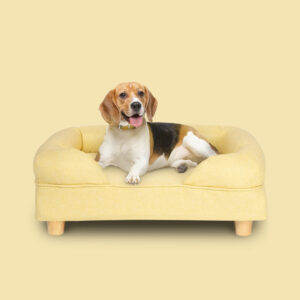
Mostly As: It is clear that your dog is as relaxed and easy going as dogs come; they are happy to go along with most things as long as they have a comfy bed to come back to for a snooze. A Mellow Yellow bed will be perfect for him or her to rest their head on after walks and play.
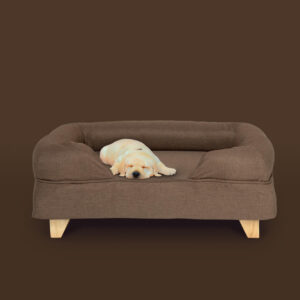
Mostly Bs: Your dog is a fiesty one, full of energy and play. We think that a Mocha Brown bed will be perfect for him or her. The soft and subtle brown colour will look great in any room of your house, and against whatever colour your dog’s coat is. As a bonus, the inevitable muddy paw prints front our dog’s adventures will be camouflaged on the bed!
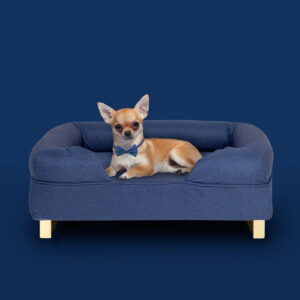
Mostly Cs: Midnight Blue is no doubt the colour for your dog. A stylish and sensitive soul, he or she will love relaxing against the calming blue after a busy day out on the town, and you will appreciate the way the dog bed adds a bit of colour to your home while still blending in nicely with the rest of your furnishings.

Mostly Ds: It’s clear that your dog will love a Lavender Lilac dog bed. They are a social creature who want nothing more than to spend time with their favourite humans, it doesn’t matter if it’s on a walk or lying in the corner of the kitchen while you’re having dinner. The relaxing dark purple colour will be great for when they are tired and need to wind down.
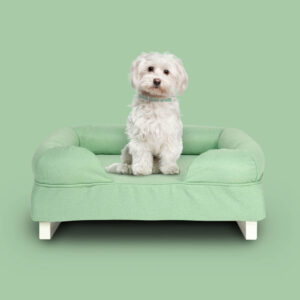
Mostly Es: Your dog is adventurous and has lots of energy, he or she probably never slows down, and is always happy to chase a ball in the garden or go for a run across the fields. You’re probably very similar, so we think a Matcha Green bed will be perfect for those rare times when they actually retreat to their bed to rest those legs.
This entry was posted in Dogs
It is a common myth that dogs only see in black and white. This is not the case, although their colour vision is limited compared to humans.
In that case, you may now be wondering “well, what colours can dogs see then?”, and how exactly do we as humans know this?
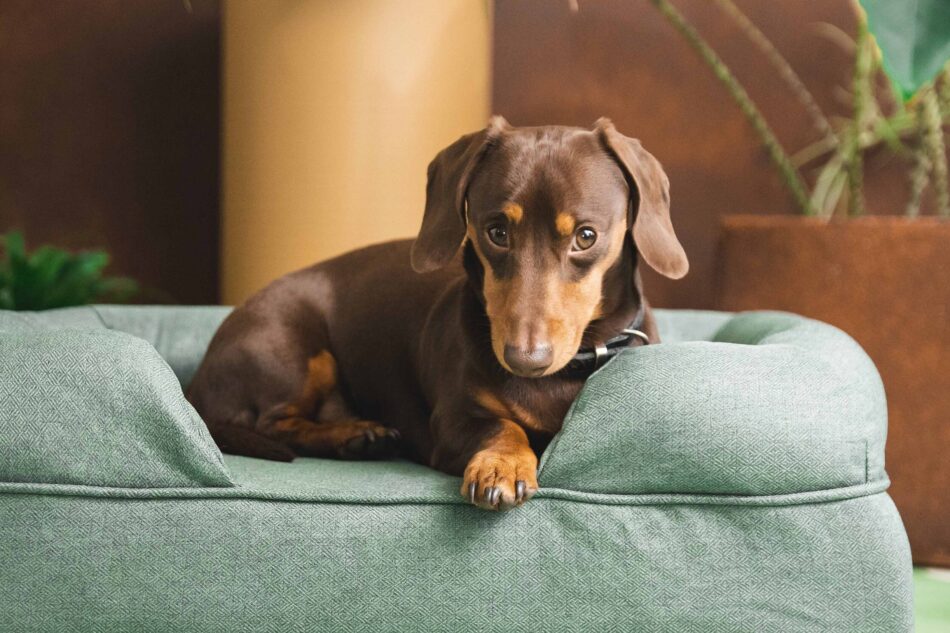
What colours do dogs see best?
The first question on your mind might be “what colours do dogs see best?”. Well, whilst the average person can see ‘all the colours of the rainbow’, from red to violet, dogs don’t have the same light receptors in their eyes as we do. To them, the rainbow is missing the red half of the spectrum. They can, however, see the yellows and blues. Indeed, a rainbow, to a dog’s eyes, is a series of yellows and blues of different shades.
What colours can dogs not see?
The ‘missing’ reds and oranges will appear to dogs as the various shades of light brown labelled ‘tan’. The greens in grass, trees and other plants are also tan to a dog. That bright red ball lying in the lush green grass may be very clear to you, but to your pet dog, the ball and the grass are both brown. Buy your dog a yellow or blue toy, however, and it will be as visible to your dog as it is to you.
Luckily for dogs, they rely on their sense of smell more than sight, so locating that ball in the grass won’t be so tricky, no matter what colour the toy is.
Can dogs see colours in their beds and toys?
As long as you don’t decorate your dog’s crate, Fido Nook or another cosy corner with reds, oranges and greens (which will all appear brown to a dog), they will appreciate a splash of colour. There’s nothing wrong with shades of tan either!
There is no evidence, either, that a dog prefers a blue or yellow ball to a red or green one. They will, however, be likelier to lose track of a light brown ball in the light brown grass.
How do dogs see colour?
In the earliest research into animal vision, dogs were taught to choose a disc that was a different colour from the others by touching the odd-one-out with their noses. If they chose the right one, they were given a treat – always a great incentive, as any dog owner knows! Sometimes, however, even the most well-trained dogs struggled to identify the odd-one-out. This told the researchers that the dogs were unable to distinguish between certain colours. When the discs were all red, apart from one green one, all the dogs could see were light browns!
Scientists are also able to use electroretinography to measure how animals’ eyes react to light. It was soon confirmed that key ‘cone cells’ responsible for registering colour in human brains were absent in dogs. Humans have three types of cone receptors, while dogs only have two.
Do dogs have good eyesight?
It may come as a surprise to many people that dogs, in addition to their poorer colour vision, cannot see as clearly as humans. Beyond a certain distance, everything becomes blurry for them. They have a genetic short-sightedness that prevents them from seeing distant objects clearly. The degree of short-sightedness varies between dog breeds, and it comes as no surprise to learn that so-called ‘sight hounds’ such as the Afghan Hound, Greyhound, Irish Wolfhound, Scottish Deerhound and Whippet have better eyesight than Chihuahuas, Pugs and Bulldogs.
However, dogs’ eyesight comes into its own at dawn and dusk, when they can see just as well as they do in the daytime. Like cats, they have retinas that function well in poor light. The shape of their eyes’ light receptor cells and a reflective tissue layer at the back of the eye combine to create this low-light supervision.
And yes, that reflective layer is why dogs’ (and cats’) eyes always have a ‘red eye’ effect in photographs, and in car headlights. (Don’t worry though, we’ve got some top tips on How To Take Better Photos of Your Pets!). No wolf pack in a horror film would be complete without those glowing eyes!
Dogs also have a broader field of vision than humans, as their eyes are more on the side of the head than ours. This enables them to take in details that we would either miss or would be half-glimpsed things seen ‘in the corner of the eye’.
Why do dogs see less colour than humans?
Dogs evolved as hunters, just like modern wolves. On the one hand, this might make you assume that fantastic vision would be essential, as it is, say, in a bird of prey. However, the difference between a dog and an eagle is that the dog evolved to hunt at night, or dawn and dusk. A hunter doesn’t need full-colour vision at night, as colours simply disappear when the sun goes down. The key skill is to detect motion and to see things vividly in the half-light. In these respects, dogs’ eyes excel, and their eyes are super-sensitive to movement.
Humans, in contrast, evolved as daytime hunters, and that’s why we have better colour vision. At night, our eyes are hopeless without some kind of artificial light. At dawn and dusk, our brains have great difficulty identifying moving objects with certainty. That’s why ghosts, goblins and other supposedly supernatural sightings occur at these times of day – they are a function of our brain trying to busk in the half-light!
Human vision, then, contains more colour than a dog’s. However, we are certainly not top dogs when it comes to colour vision in the wider animal world. Many insects, including bees and butterflies, as well as many fish and crustaceans, have far more light receptors than we do and can see far more colours in the rainbow and the world around them.
But a dog’s vision is still perfect – for a dog!
We might see the world differently from our pet pooches, but what owner and pet can both agree on is that our furry friends deserve to live a life of luxury! Shop Omlet dog products today to find the perfect Dog Bed, Dog Crates and Dog Accessories for fido!
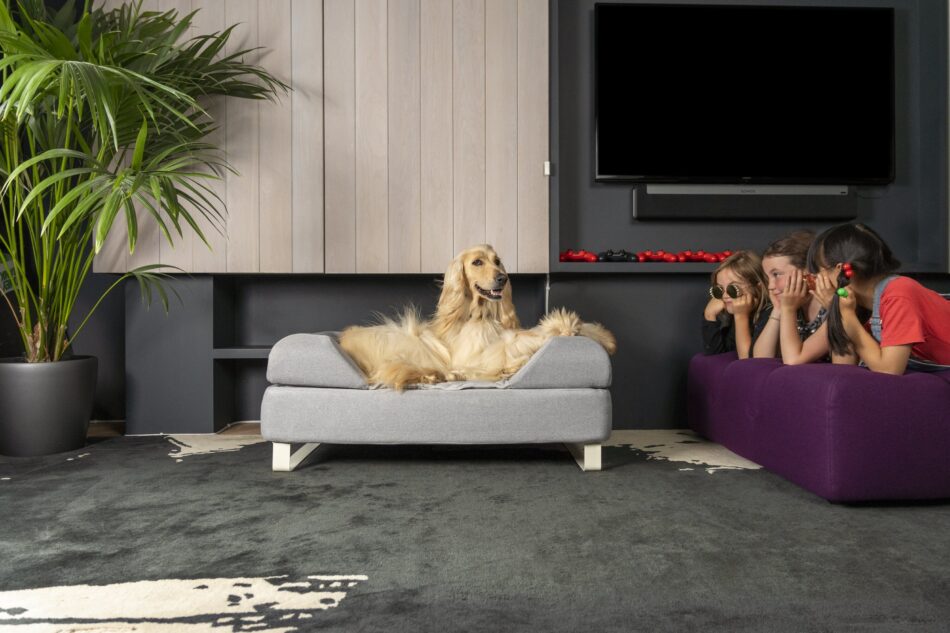
This entry was posted in Dogs

If you share your home with a dog, it’s important to make sure the space is just as comfortable, hygienic and safe for them as it is for you. With these 5 dog-friendly interior tips for your home, you can be assured they’re staying safe, whilst your home stays in tip-top condition.
1. Materials matter
This is a simple idea but one that will save you a lot of cleaning time and expense in the long run. Opt for washable sofa covers wherever possible and steer clear of materials that can easily be scratched or will likely attract loose fur. Removing pet hair from your home can be done but it can also be a hassle, especially when it’s partially preventable. Some dogs will need grooming more than others, but brushing your dog regularly will help keep fur off furniture as well.
The same goes for flooring – choose something easy to mop or wipe, especially after a muddy dog walk. A machine-washable dog mattress like our Bolster dog bed will also help to minimize dirt and fur in your home. Simply unzip the cover and machine wash to maintain home hygiene and fresh sheets for Fido.
2. Styling your dog’s bed to your home
Your dog’s bed no longer has to stand out awkwardly in your home. Omlet’s Bolster dog beds are available in 15 bold colours to suit your interior style. Matching the colour of the dog bed to an accent colour in any room can be a great way to integrate their bed with your interior style, and really make it part of the home.
Plus, you can even raise your dog’s bed from the ground for an impressive touch with our range of designer dog bed feet. With the choice of 9 different styles of feet, there’s a dog mattress and feet combination for every home and dog. Curious for more interior styling tips? Find out whether your dog’s bed matches your decor.
3. Dog crate or stylish furniture?
A stylish dog bed needs a stylish dog crate to match. Dog crates are recommended by dog trainers and veterinarians for their many benefits. Not only do they offer a relaxing space for your dog to call their own, but they can also provide comfort and security, especially for puppies and anxious dogs when feeling overwhelmed.
Standard dog crates can be an eyesore in a beautifully decorated home, but we worked to curate a product that doubled as a doggy den and piece of furniture. Introducing the modern Fido Studio dog crate…Available in a Walnut or White design, you can even also an optional wardrobe with a handy storage unit for your dog’s toys and treats (or maybe clothes!). To finish the look, you can seamlessly slide in your Bolster dog bed to create the ultimate hideaway for your four-legged friend and a chic corner in your home.
4. Remove temptation
Most owners of excitable dog breeds will be well-practised in drink-saving reactions to prevent a whipping tail from causing carnage. It’s important to keep breakable or potentially harmful items like candles and glasses up high, not just for your sake but also for your dog’s safety. It’s wise to opt for higher side tables rather than lower-sitting coffee tables for tea and snacks to move the temptation of tasty human treats out of sight.
Dogs that are physically and mentally stimulated are less likely to be destructive in the home as well. Ensure that regardless of your dog’s breed, they’re provided with enriching activities in addition to their daily walks. You can exercise your dog indoors by playing games such as hide and seek, teaching your pup new tricks or even creating an obstacle course using materials you can find around the house.
5. Plants and pets
You can still enjoy house plants and a beautiful backyard when you have a dog but it goes without saying that you should first check they’re not toxic. This isn’t an exhaustive list but the following plants can be dangerous to dogs:
- Aloe vera
- Onion and garlic plants
- Ivy
- Bluebells
- Daffodils
- Grapevine fruits
- Mistletoe
- Holly
There are plenty of plant species that are also dog-friendly, though. These include but are not limited to:
- Magnolia bushes
- Rosemary
- Fennel
- Pansies
- Wheatgrass
- Sunflowers
- Lavender
It’s also worth noting that if your dog loves mud, you might also prefer to keep houseplants up out of reach of digging paws!
Omlet and your dog’s home
With Omlet’s range of dog products such as our easy-to-clean dog beds and stylish dog crates, you can continue to build a wondrous connection between you and Fido, all while your and your dog’s home remains a safe haven and looks great too.
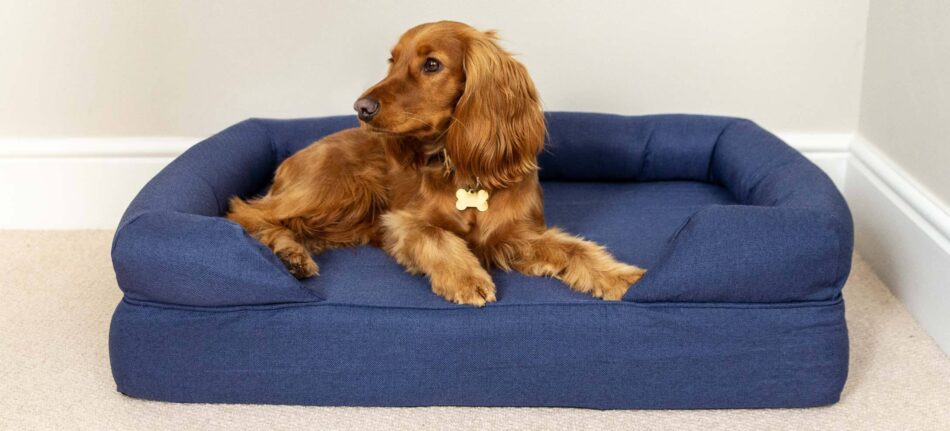
This entry was posted in Dogs
Exercising doesn’t always come easily — in fact, lack of motivation is one of the most common reasons people don’t participate in physical activity. But having a partner to work out with can make all the difference, especially when that partner brings a positive attitude and a wagging tail to the table. Here’s why dogs make great workout buddies, and how you can start exercising with your pup to give you both a healthier leash on life.
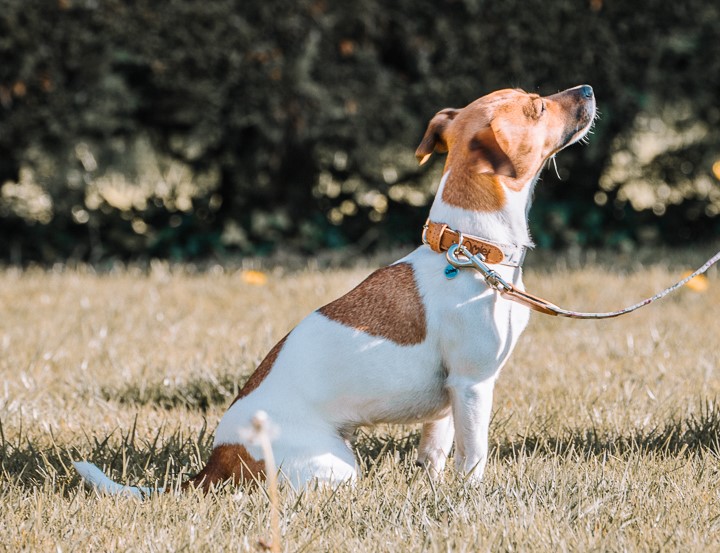
5 Reasons why dogs make great workout buddies
There are several reasons to exercise, and they’re as true for you as they are for your dog. Better physical health, maintaining a healthy weight, and increased mental well-being are just a few benefits that physical activity offers for humans and canines alike. Here’s how you and your dog can keep each other accountable and motivated throughout your healthy lifestyle journey.
1. Dogs are energetic
When’s the last time you saw a human jump for joy at the sight of their running shoes? In contrast, a dog’s reaction to seeing their leash is usually a mixture of unbridled excitement and elation. Depending on the dog, this energy can last anywhere from several minutes to the duration of your workout together, lending you the support and motivation you need to get going.
2. Pups set the pace
Dogs are very good at setting a steady pace. Once they find their stride, you can count on your pup to help set the pace for your workout. Match your cadence to canine’s, and find a familiar rhythm in the wag of their tail or the pattern of their panting. This natural soundtrack to your workout is soothing and motivating, and gives you a focal point if you start to lose steam.
3. Safety in numbers
Running or walking alone isn’t just dull, it can be dangerous. Depending on when and where you do your workouts, there can be concerns of various types. The presence of your pup can provide peace of mind, as their ears and noses are much more sensitive than a human’s. Your dog will be able to sense trouble before you do, and will help deter unwanted encounters.
4. Their schedule’s always open
No more waiting for schedules to align with your human workout buddy — your dog is always available. Since your dog is part of your household, your schedules are already in sync with each other, making exercising together even easier. Dogs are also habit-forming animals, so by setting a schedule to workout with them, they’ll come to expect it. Keep their leash in its designated spot, and try to workout at the same time each day. You’ll soon find your pup gravitating toward their leash as your regular exercise time nears to help keep you accountable.
5. Good vibes only
You’ll never hear a complaint or criticism from your canine, only quiet companionship and confidence. The positivity from your pup is often one of the greatest motivators you can find. No more listening to a personal trainer yell instructions to you — let your dog do the barking.
Dog breeds that make the best workout buddies
Exercise benefits all breeds of dogs, but depending on your level of intensity, you may need to modify your workout to your dog’s ability. For example, dogs with short legs like Dachshunds or Corgis won’t be able to run an entire 5k with you, but they can work up to walking one. Similarly, dogs with “smooshed” faces like Pugs, Bulldogs, or Boston Terriers have restricted airways and shouldn’t be pushed to the point of exertion. Puppies and senior dogs also may not be able to keep the pace with you over long distances.
If you’re looking to adopt a dog and want to incorporate them into your active lifestyle, consider these breeds:
High energy, athletic dog breeds
- Australian Shepherds
- Border Collies
- Boxers*
- Dalmatians
- Doberman Pinschers
- English Springer Spaniels
- German Shepherds
- German Shorthair Pointers
- Greyhounds
- Jack Russell Terriers
- Labrador Retrievers
- Siberian Huskies
- Vizslas
- Weimaraners
*Boxers are a brachycephalic breed, which means they are “snub nosed” and more prone to respiratory distress.
Other breeds may be up to the task of exercising with you, including mixed or smaller breeds. The most important thing is that your pup has received a clean bill of health from your veterinarian, and that you modify workouts as needed to adjust to their ability.
Exercises to do with your dog
So, you’ve decided to be disciplined with your dog and commit to working out — but what disciplines can dogs join you in? The most common exercises that owners take their dogs along for include running and walking, but there are some other activities you can include your dog in. Consider these dog-friendly workout ideas:
- Hiking
- Swimming*
- Kayaking, rowing, or canoeing*
- Yoga
- Cycling
- Dance
*Make sure your dog is fitted with an approved life jacket during these activities.
If you’re heading outside for a workout, choose a time of day where the temperature is moderate. Never exercise outside with your dog in the middle of the day during the hotter months — this can cause heat exhaustion or even heat stroke in dogs, especially breeds with heavy coats. So what temperature is too hot for your dog? When the real-feel temperature reaches 85°F or higher, it’s best to stick to indoor activities. And be sure to check the pavement with the back of your hand before you set out with your dog — if it’s too hot for your hand, it’s too hot for their paws.
Take plenty of water and offer your dog small sips every 15-20 minutes during activity. Plan their mealtimes at least 2 hours before exercising, and wait at least an hour after a workout to feed them to prevent digestive upset. Be sure to take cleanup bags with you — what goes in, must come out, and exercise often stimulates the intestines.
Omlet and your dogs
There’s nothing quite as sweet as that post-workout nap. Give your pup a comfy dog bed to sink into, or a supportive dog crate to retreat to after their cool down. Offer them nourishment and hydration in stylish dog bowls to help them feel their best, so they’re always ready for adventure. With Omlet, you and your dog can enjoy a lifetime of companionship together — both at home and on the go.
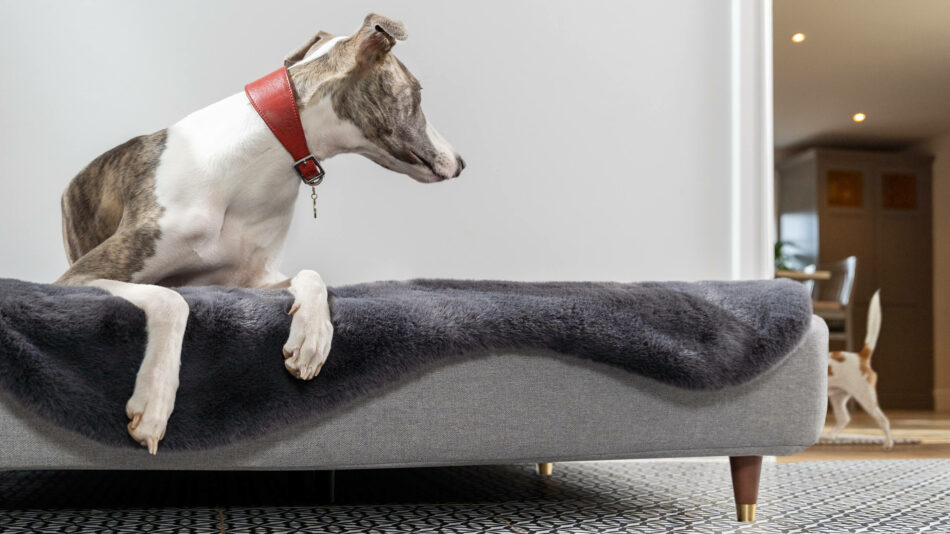

This entry was posted in Dogs
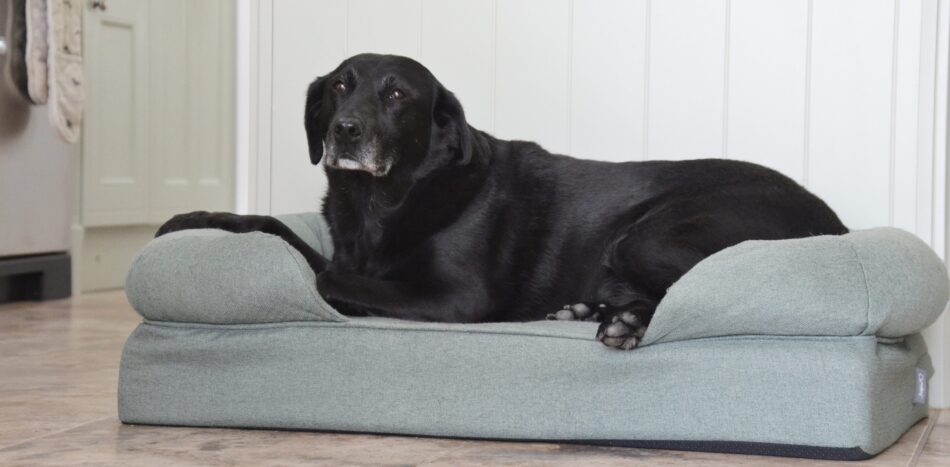
Dogtor™ Adem, Dog behaviourist & trainer, discusses everything you need to know about dog beds, which types may suit which breed and age of dog, and why we might see our four-legged best friends exhibit certain behaviours in and around their beds. Read on to learn more!
What should I look for in a dog bed?
A dog bed should be comfortable for the breed type, age and size of your dog. If you have an older dog, they might benefit from an orthopedic or memory foam bed, such as the Omlet Bolster Bed with premium memory foam mattress, which gives support by gently moulding around your dog. A puppy, on the other hand, might benefit from a bed that can absorb water if, for example, a bowl of water is accidentally knocked over by them or they ‘toilet’ on their bed area whilst still being house trained. For puppies, you may also want to consider a type of bedding that is comfortable for them but not too precious or expensive due to the higher risk of this bedding being chewed or damaged as they play and explore. For me, it is also important to choose a bed that is robust and can be easily washed. Again the Omlet Bolster bed is a great choice with this feature! This not only helps the environment by limiting the need to frequently replace a smelly or very worn dog bed with a new version, but also ensures any accidents or dirt brought into their dog bed area can be easily cleaned away, keeping their bed area hygienic and inviting. You could also consider covering your dog’s bed with a removable and washable cover, particularly in the winter months.
What type of bed might suit my breed of dog?
Certain breeds might need more cushioning than others to stay comfortable and limit their potential for developing sores or sore patches, for example greyhounds who are considered more ‘boney’ than many other breeds. Some breeds might also like to curl up, for example a husky or some of the smaller breeds, whilst others prefer to lay on their side and stretch out, for example hounds such as deer hounds, greyhounds, and lurchers. An owner should consider how their individual dog likes to lay and relax and choose a suitable bed with this in mind.
The time of year can also have an effect on where your dog chooses to sleep. To ensure your dog remains comfortable, you can adapt their bed to suit the season by adding extra blankets or even cool mats to your dog’s bed. If you’re looking for a cozy blanket, Omlet’s Super Soft Dog Blanket is definitely a winner for those cooler months where some dogs might like to ‘snuggle up’. For the warmer months of the year, you could try a cool mat instead of their usual bed if it is particularly hot! Omlet’s Cooling Mat for Dogs is a perfect choice, coming in a range of sizes to suit many breeds.
I have observed my dog ‘digging’ their bed, why is this?
This is a natural instinct derived from the need to ‘clear the ground’ or an area of insects and potentially small rodents and reptiles. Ancestors of our pet dogs might need to do this in order to make the area they are choosing to reside in safe for them to lay down in. Some dogs, such as those in tropical climates that predominantly live outside or live as ‘street dogs’, still use this instinctive behaviour to keep themselves from being bitten and stung. This act of ‘clearing the ground’ may even have benefits in preventing parasite infestation. Whilst in Mauritius last year, I witnessed a young street dog clearing an area and whilst watching I noticed that she stopped in her tracks and became very observant as she had disturbed a small scorpion in some leaves. Without this act of digging and clearing, this dog would have undoubtedly been stung by this scorpion.
Dogs may also dig because they sweat through their paws, making the act of digging and ‘circling’ in an area another way of spreading and leaving their scent. This is something we commonly know as ‘marking’ and usually associate with the image of dogs urinating up lamp posts!
Finally, dogs may also dig naturally on hot days and in hot climates in an attempt to try to remove hot surfaces (e.g. baked earth). This helps them to reveal a cooler surface to reside in. In addition, wild canids such as arctic foxes and wolves, may dig to avoid extreme weather such as high wind, the cold (e.g. snow), and storms. Again, this act helps to keep them safe as well as assists in regulating their body temperature. Although seldom needed in the pet dog world today, this instinctive behaviour still remains in part in our domesticated dogs.
How can I train my dog to sleep in their bed?
A good training instructor or behaviourist will have this on their training syllabus, helping owners to teach the ‘go to bed’ command.
If, however, your dog is reluctant to sleep in their own bed you should investigate why. Firstly consider, is the bed area provided the most attractive sleeping area available to your dog? Positive reinforcement such as offering treats in this area can help to make their bed area a more positive and inviting place to reside, as can ensuring the bed is comfortable for their breed type and age (as discussed above!) Secondly, you might want to evaluate if your dog potentially has a behavioural issue such as separation anxiety that is preventing them from wanting to sleep in their own bed. If you believe this to be the case, you should seek help from a certified behaviourist to address this issue and help to build your dog’s confidence in being physically away from you.
How can I stop my dog destroying their bed?
Think about your dog’s life stage. A young puppy may chew a bed as they explore with their mouth and enjoy the texture on their teething gums. In this instance, it would be advisable to buy a bed that does not contain lots of small parts or stuffing that can be ingested. Similarly, you could pick bedding made of material that can not easily be broken down through the act of chewing. You can always buy a ‘nicer’ bed for your dog to use under your direct supervision until they have passed this life stage and have lost their baby teeth and gained all of their adult teeth.
If your dog is older and destroying their bed, perhaps when they are left alone for example, this could potentially signal that your dog is feeling stressed and is suffering from separation anxiety, for which behavioural advice should be sought to enable your dog to recover from this issue.
Similarly, chewing and destroying of beds can also sometimes indicate that your dog is bored. To combat this, you could look to try to tire your dog more effectively before leaving them alone, which will encourage them to rest more in your absence. You should also ensure that your dog is not left for long periods of time by themselves. Just like us, dogs are social mammals and need company. As well as ensuring your dog is appropriately exercised and is not being left for too long, you can also offer your dog something to do for some of the time you are away from them. For example, you could leave them something else to chew that is safe and made for this purpose. Consider leaving them with a hard chew food item or a food dispensing toy filled with tasty treats for them to try to get to!
I hope you have found the above information useful. Wishing your beautiful pooches the most restful of snoozes!

Dogtor™ Adem
Dog Behaviourist & Trainer
www.dog-ease.co.uk
@dogtoradem
This entry was posted in Dogs
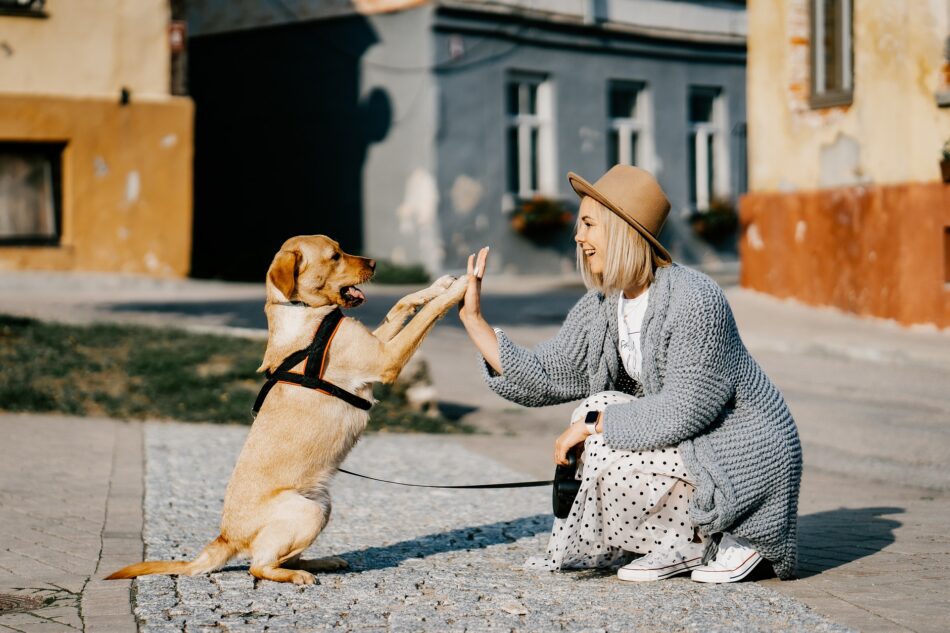 A dog who has been taught positive behaviour will be your best friend – fun, affectionate and reliable. It’s straightforward teaching your dog this canine version of positive thinking, but it won’t happen unless you lead the way.
A dog who has been taught positive behaviour will be your best friend – fun, affectionate and reliable. It’s straightforward teaching your dog this canine version of positive thinking, but it won’t happen unless you lead the way.
There are many ways of teaching a dog the rights and wrongs of living in the human world, and that extends to how they interact with other dogs and the world around them. In this article, we reveal the five rules of thumb for all dog owners – whether you’re training an adult dog or a puppy.
Encouraging Positive Behaviour in Puppies
Puppies recognise when we’re pleased or displeased. It’s all part of their instincts, and in the wild this instinct helped their wolf ancestors find their place in the pack very quickly. Learning their place in the big wide world is all about positive reinforcement.
1. Puppy Treats. Dogs of all ages love food and will put lots of effort into doing what you want them to do as long a there’s a yummy treat at the end of it! This means treat-based training can be used for everything from toilet training to basic obedience training and that all-important early socialisation. The message here is simple and timeless – do this right, and you’ll get a treat!
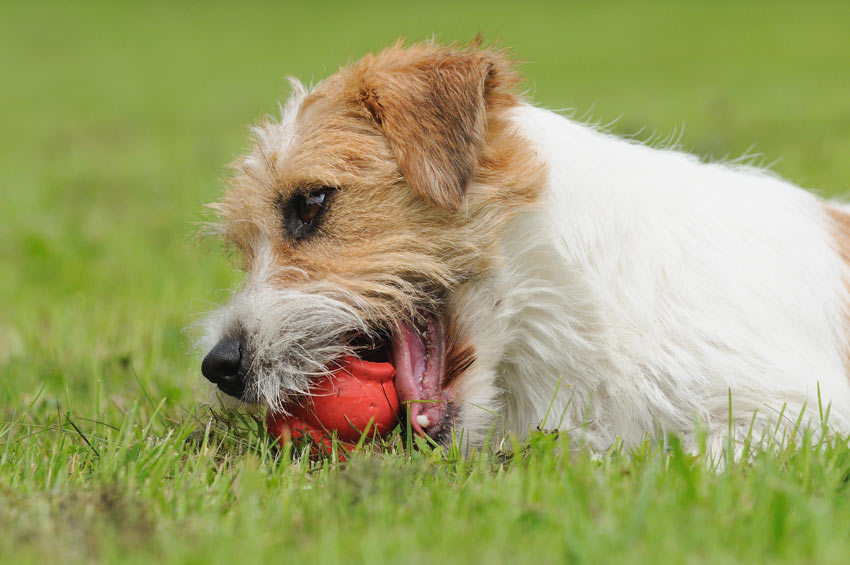 2. Affection. This is arguably even better than a food treat! Bonding with a puppy involves physical contact in the form of belly-rubs, back stroking and lots of gentle words of affection and encouragement.
2. Affection. This is arguably even better than a food treat! Bonding with a puppy involves physical contact in the form of belly-rubs, back stroking and lots of gentle words of affection and encouragement.
3. Fun and games. Tug-of-war, fetch and simply running around the garden with you are games that puppies love. What’s more, they strengthen the bond and love between you and your pet, and that’s the perfect groundwork for training and encouraging positive behaviour.
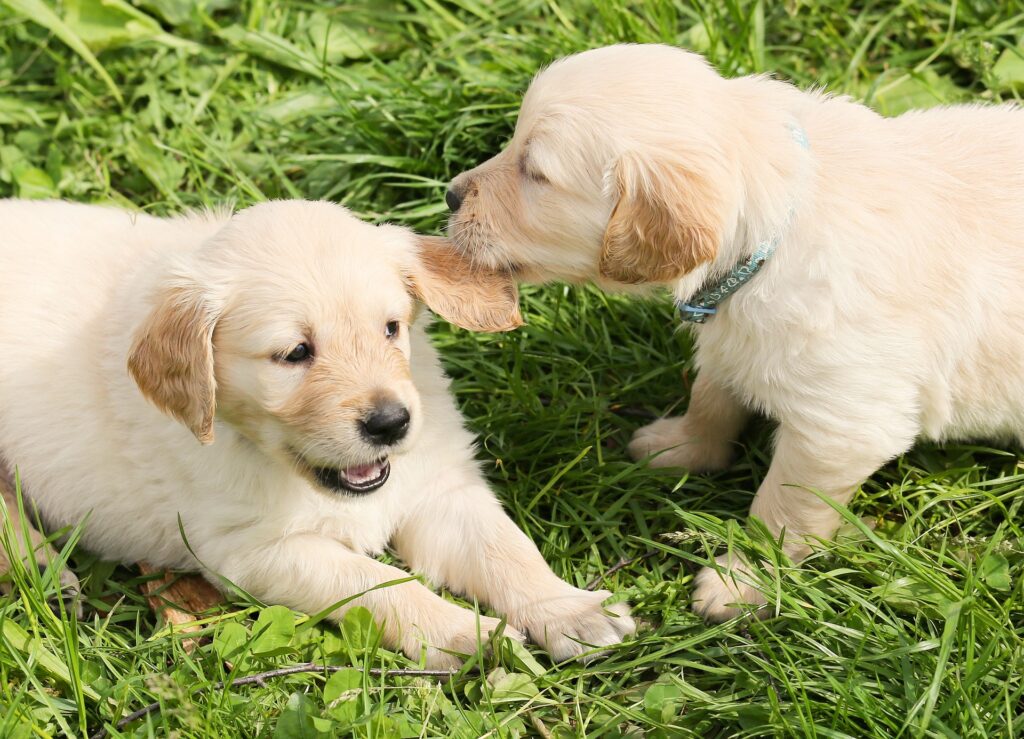 4. A trip to a favourite place. This is a great treat for dogs, and can be as simple as a trip to the park, or perhaps to a favourite street for an on-lead walk, or maybe a shop that sells some of those yummy treats! If this is being done as a reward for good behaviour, make sure your puppy knows it by telling them what a good boy/girl they are as you put the lead on or get into the car!
4. A trip to a favourite place. This is a great treat for dogs, and can be as simple as a trip to the park, or perhaps to a favourite street for an on-lead walk, or maybe a shop that sells some of those yummy treats! If this is being done as a reward for good behaviour, make sure your puppy knows it by telling them what a good boy/girl they are as you put the lead on or get into the car!
5. Puppy playdates. Starting these early is a great way to socialise your puppy, and that provides the basis for all the positive behaviour training. Young dogs love meeting each other – it’s not going to be a quiet morning out with your furry friend, but it’s one that will give him or her essential social skills.
Encouraging Positive Behaviour in Adult Dogs
The basics are simple. Positive reinforcement rewards a dog for good behaviour and ignores, rather than punishes, undesirable behaviour. Punishment will only lead to confusion and fear in your dog, reducing your chances of achieving the full benefits of positive-behaviour training.
Here are the five ways to make everything go smoothly, no matter which dog breed you have.
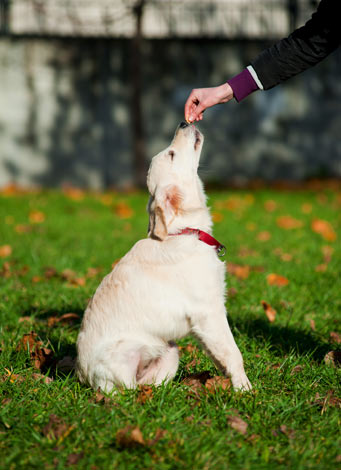 1. Keep it simple. One-word commands are better than complex ones. We’re talking here about sit, come, sat, etc. Save the long-winded exchanges for praise and affection! A training session based on simple commands and treats is a great start for encouraging positive behaviour. Which brings us to…
1. Keep it simple. One-word commands are better than complex ones. We’re talking here about sit, come, sat, etc. Save the long-winded exchanges for praise and affection! A training session based on simple commands and treats is a great start for encouraging positive behaviour. Which brings us to…
2. Treats. Just like puppies, adult dogs will be well and truly ‘reinforced’ if treats are involved. Some breeds are more food-obsessed than others, but all types of dog will quickly learn that good behaviour results – at least in the early days of training – in a yummy treat.
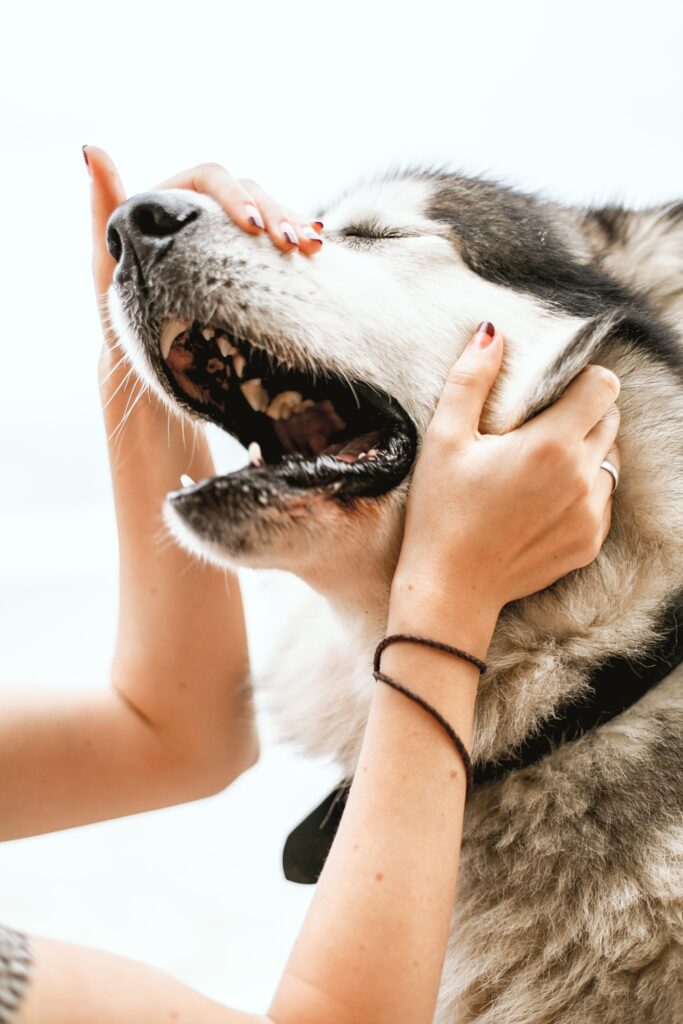 3. Quality time. Dogs are social animals by instinct, and they will thrive in human company. Once you and your pet are the best of friends, the positive behaviour training will be much easier. If there’s any nervousness or standoffishness in your dog, they will be less able to take on board the things you’re trying to teach them. So, keep up the contact, and play with them every day.
3. Quality time. Dogs are social animals by instinct, and they will thrive in human company. Once you and your pet are the best of friends, the positive behaviour training will be much easier. If there’s any nervousness or standoffishness in your dog, they will be less able to take on board the things you’re trying to teach them. So, keep up the contact, and play with them every day.
4. Make it fun. A long session of ‘sit, lie down, stay, come’, etc. will soon become boring for a dog. A short session of command-based training followed by a bit of fun, however, will make your dog look forward to the sessions every time. After five or ten minutes (depending on your dog’s stamina), round off the proceedings with a game or a walk. The dog will soon realise that “If I do this tricky bit, I get that fun bit afterwards!” It’s a trick that works just as well with young children – “Finish your homework, and then we’ll go out on the bikes!”, that kind of thing.
5. Get everyone involved. Once your dog has grasped some of the basics, other members of the family, or friends, can reinforce the good behaviour by running through some of the training with your dog. Your pet will then learn that positive behaviour is part of their general lives and applies in all situations with all people.
This latter point is the ‘quantum leap’ for a dog – the idea that positive behaviour extends beyond their immediate owner to the big wide world around them. Getting them to this point takes time, there’s no doubt about that, and some breeds are a lot easier to train than others. However, once the work has paid off, you’ll have a doggy best friend you can be truly proud of!
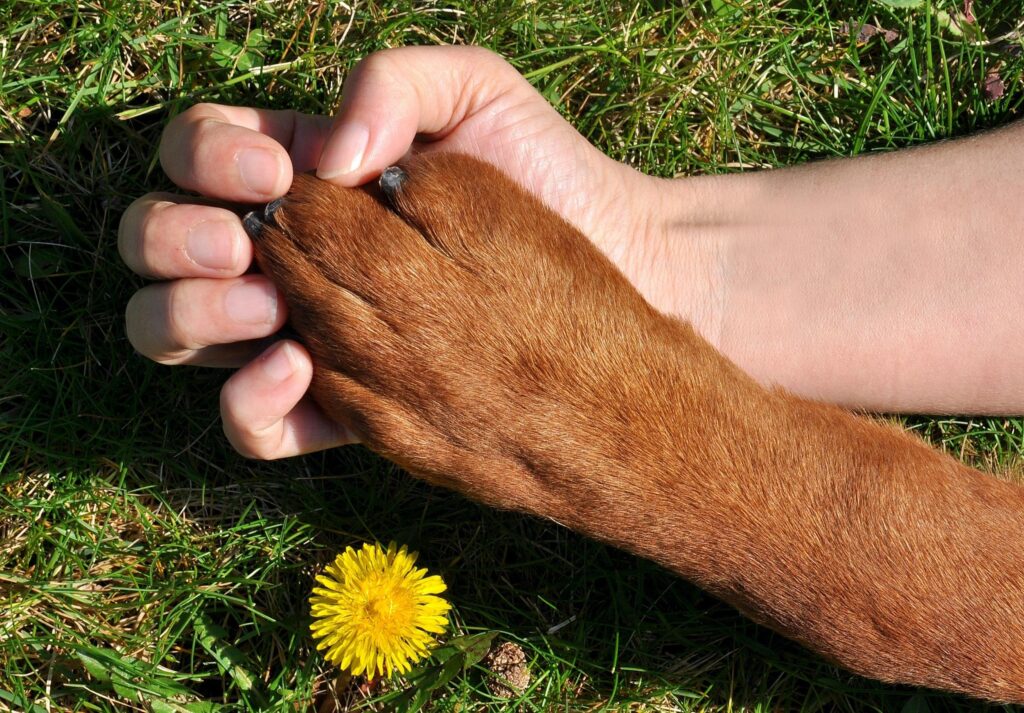
This entry was posted in Dogs
David is a long time lover of dogs since he was young. He loves most dogs but his favorite are golden retrievers. He also runs his own blog at dogdesires.co.uk where he helps other dog owners with advice and dog product reviews. In this article David gives 5 considerations for finding the right dog breed for you.
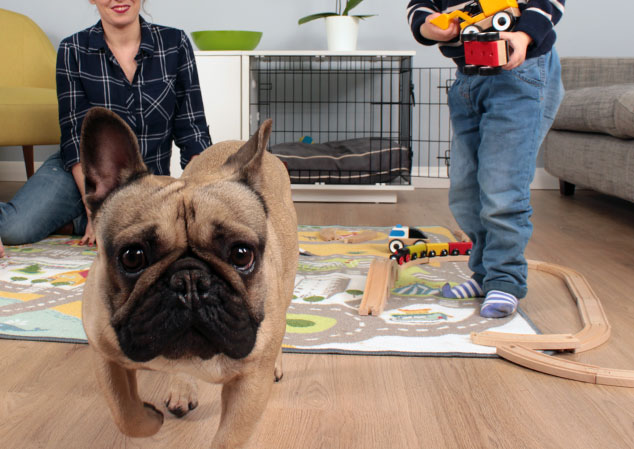
There are several things you need to consider in order to choose the right dog breed for you. Depending on your lifestyle, certain breeds are more suited for you because of their size, maintenance, activity level, and more.
Read on for more detail and by the end of this article, you will have the insight needed in order to choose the ideal dog breed for you.
Size
Some people already have their hearts set on whether they would like a huge dog or a tiny one. Those who aren’t sure or that bothered about it tend to go for medium-sized dogs.
One thing that is an important deciding factor regarding what size breed is best for you is your living conditions. Naturally, large dogs need a lot of space so if you’re living in a relatively small and cozy apartment you would not want to get a Great Dane. They especially need more room because of their tails, so that they can wag without injuring anyone or damaging anything.
That being said, living in an apartment does not automatically mean you must get a toy dog. Some dog breeds are known for being adaptable to living in apartments, such as the Sheepadoodle. If you’d like to read more about this breed, you should check out this breed guide here – Sheepadoodle.
Keep in mind that small dogs are more vulnerable, in the sense that you need to get used to always looking down to not step on them. Smaller dogs also tend to be more sensitive to the cold so they need a little help staying warm.
Maintenance
With maintenance comes many things. Firstly, some breeds have fur that needs a lot of maintenance to stay healthy. Dogs with short fur are easy to take care of, such as Springadors, as they just need brushing every now and then. But dogs with longer fur, curly or otherwise, need to be brushed more frequently as well as trimmed and more. So, you will need to dedicate more time to these dogs.
Another factor is the expense. The larger the dog, the more food you need to buy and larger dog beds, etc.
Lastly, there’s training. This is very important, as some dog breeds are known for being more well-behaved and thus easier to train. Smaller dogs tend to have something that is referred to as ‘small dog syndrome’, which is when a small dog thinks that they are bigger than they actually are and therefore have more of an attitude. This can cause them to be more stubborn when it comes to training. For example, pugs are known for being naughty and for being stubborn.
Another good thing to remember is that if you let a large dog breed behave as a lap dog from a young age, they will continue to try and walk all over you when they become adults – and I mean that literally, not figuratively.
Also, dogs with long and floppy ears need frequent and thorough cleaning as they are more prone to ear infections. Moreover, certain dogs are more likely to drool than others such as Bloodhounds and Mastiffs.
Activity Level
If you get a hunting dog breed, such as a Labrador, Beagle, Foxhound, etc., then you can expect this dog to have a high activity level. Even crossbreeds with a hunting dog parent tend to inherit the genes and have a lot of energy.
Most dogs do not destroy things and dig up holes in your yard without a reason; energetic dogs, in particular, need much more exercise and become bored and destructive without it. Mental exercise, as well as physical, is a must too.
No matter the breed or size though, all dogs need routine exercise. You will need to commit to going for walks twice a day and if you’re looking for a dog that you can jog with then a Weimaraner or German Shepherd are great choices.
Personality
This one goes without saying for some people, but seeing as certain breeds are known for having certain personalities, we can use this to our advantage. For those of you who are looking for a cuddly and loving dog, Retrievers, Greyhounds, Irish Wolfhounds, Old English Sheepdogs, Pitbull Terrier, and King Charles Spaniels are known to be some of the most affectionate dog breeds.
Restrictions
Unfortunately, depending on the country and state you’re in, some breeds may be banned.
To give an example I would like to name Pit Bulls and Rottweilers. Both of these dog breeds are sadly banned in many states, the reason being that they face stigmas as ‘dangerous’ and ‘aggressive’.
Personally, I would like to note that I have had several dogs of both of these breeds and none of them ever showed any signs of being aggressive or dangerous in any way. They were sweet, kind, and several of the Rottweilers were protective over me.
I do not believe for a second that aggression can be inherited in genes, but rather it comes about when a dog is being raised wrongly.
This entry was posted in Dogs
 Autumn is here so why not kick off the new season by starting a new project or getting organised! it presents the perfect opportunity to have a bit of a change! So why not get your cat or dog involved with your overhaul so that they can start the season in tip-top condition! So, how do you begin to clean up your cat or dog’s life?
Autumn is here so why not kick off the new season by starting a new project or getting organised! it presents the perfect opportunity to have a bit of a change! So why not get your cat or dog involved with your overhaul so that they can start the season in tip-top condition! So, how do you begin to clean up your cat or dog’s life?






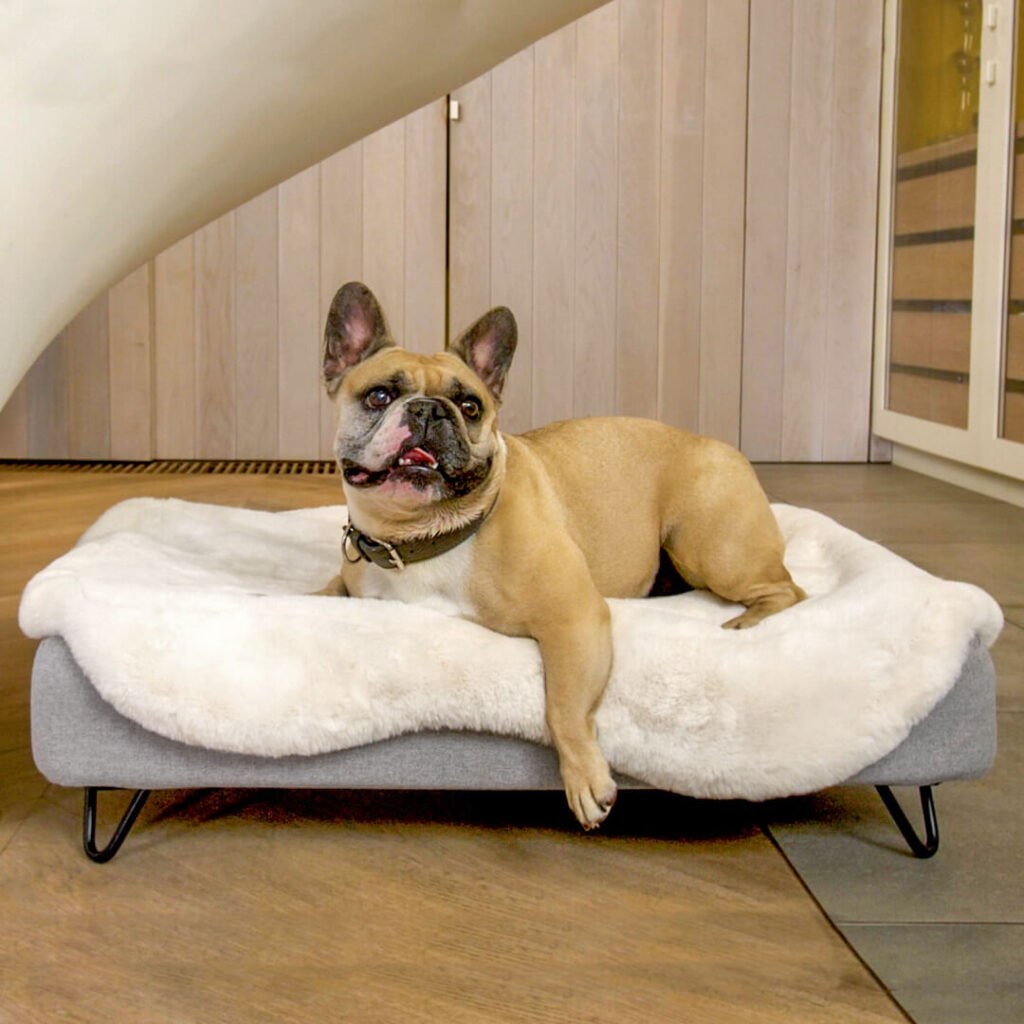
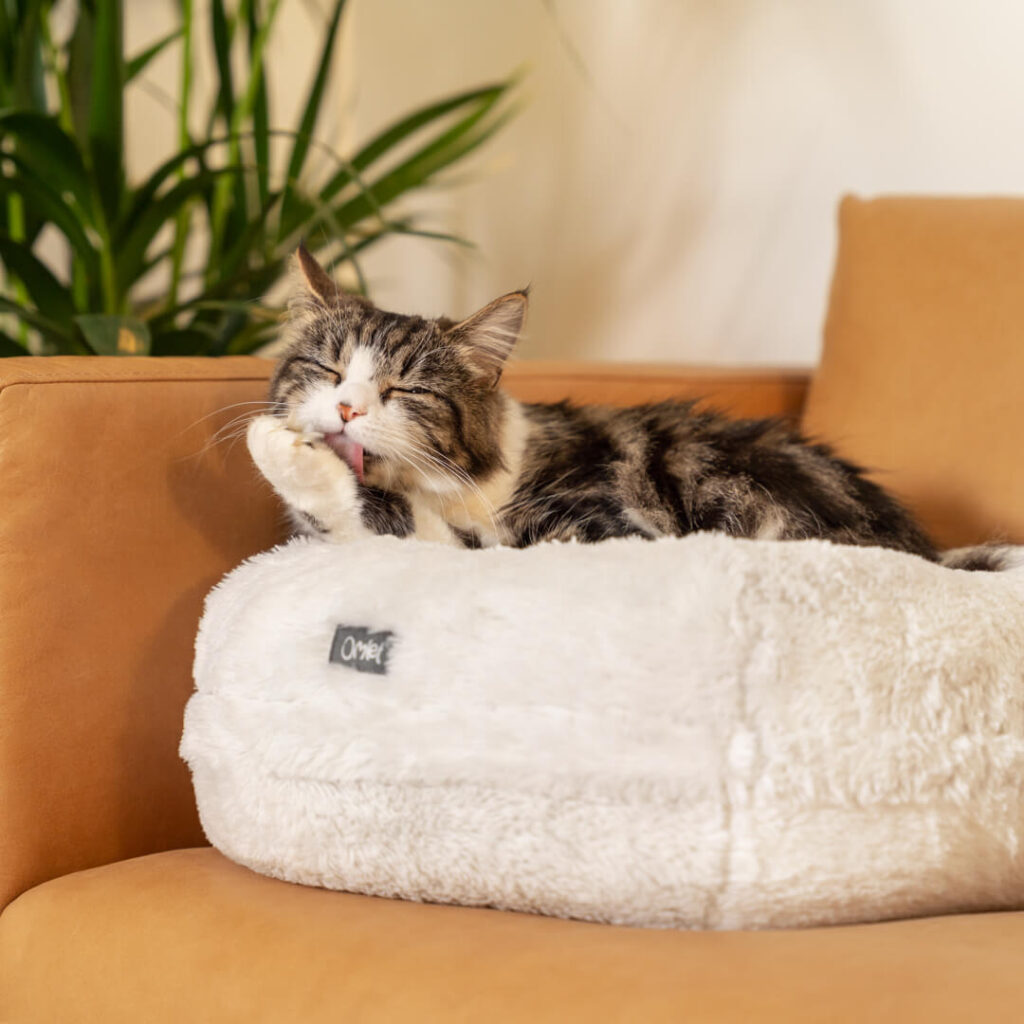





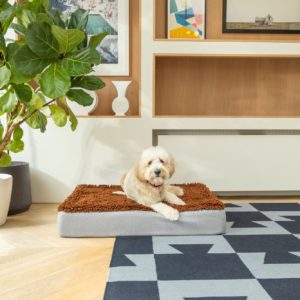
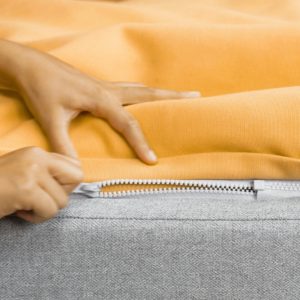


 Regular Grooming
Regular Grooming Wipe Your Dog’s Paws After Walkies
Wipe Your Dog’s Paws After Walkies








 Play Fetch in The Living Room
Play Fetch in The Living Room
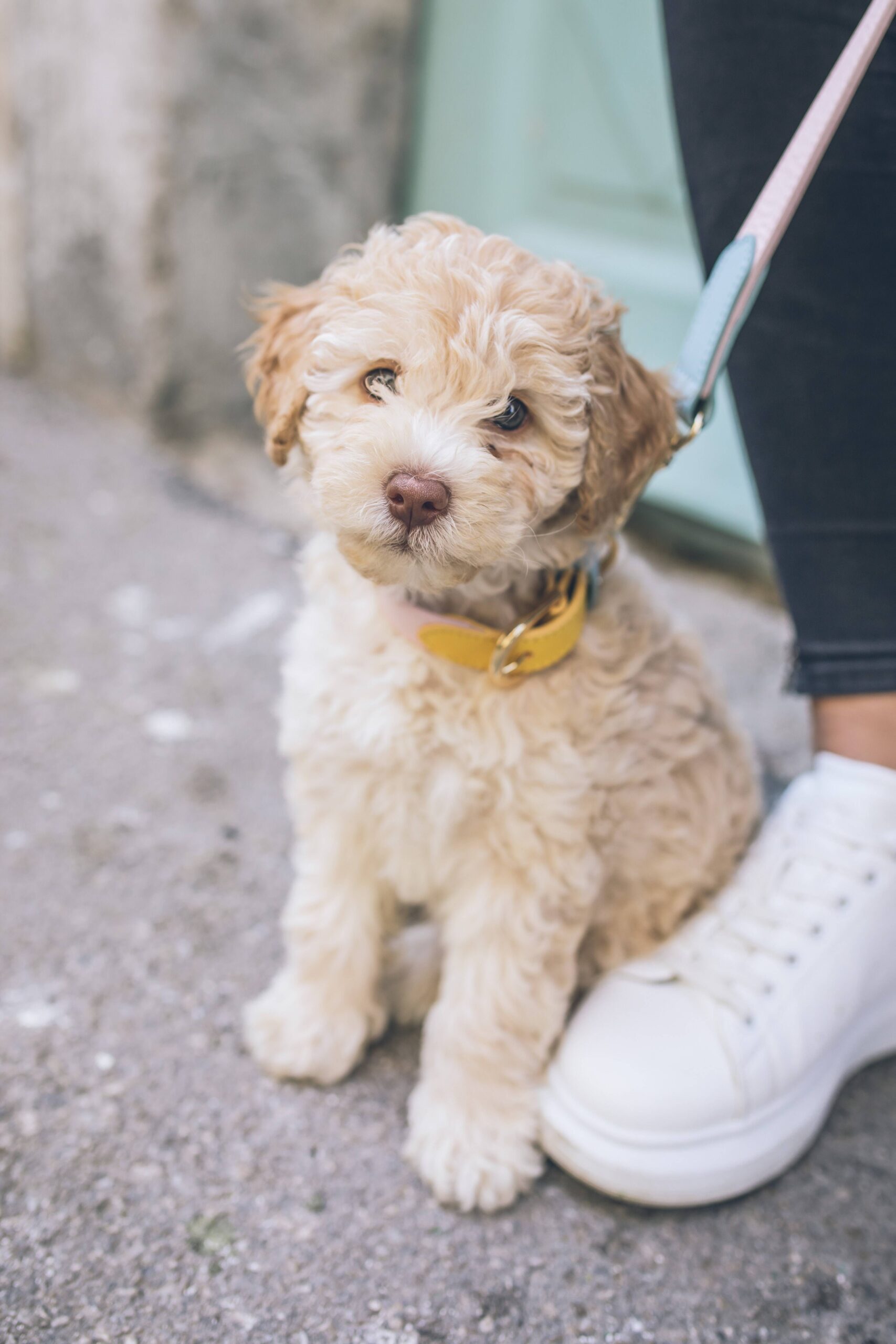
















 A dog who has been taught positive behaviour will be your best friend – fun, affectionate and reliable. It’s straightforward teaching your dog this canine version of positive thinking, but it won’t happen unless you lead the way.
A dog who has been taught positive behaviour will be your best friend – fun, affectionate and reliable. It’s straightforward teaching your dog this canine version of positive thinking, but it won’t happen unless you lead the way. 2. Affection
2. Affection 4. A trip to a favourite place
4. A trip to a favourite place 1. Keep it simple
1. Keep it simple 3. Quality time
3. Quality time
